Search
SmartReach is your all-in-one, AI-powered solution for intelligent, automated survey delivery. It helps you reach the right people, at the right time, through the right channel automatically. As a multi-channel distribution engine, SmartReach enables you to send surveys via Email, SMS, and WhatsApp.
You can let AI manage the entire distribution process, or create custom workflows tailored to your audience’s behavior and communication preferences, combining the best of automation and personalization in one powerful platform.
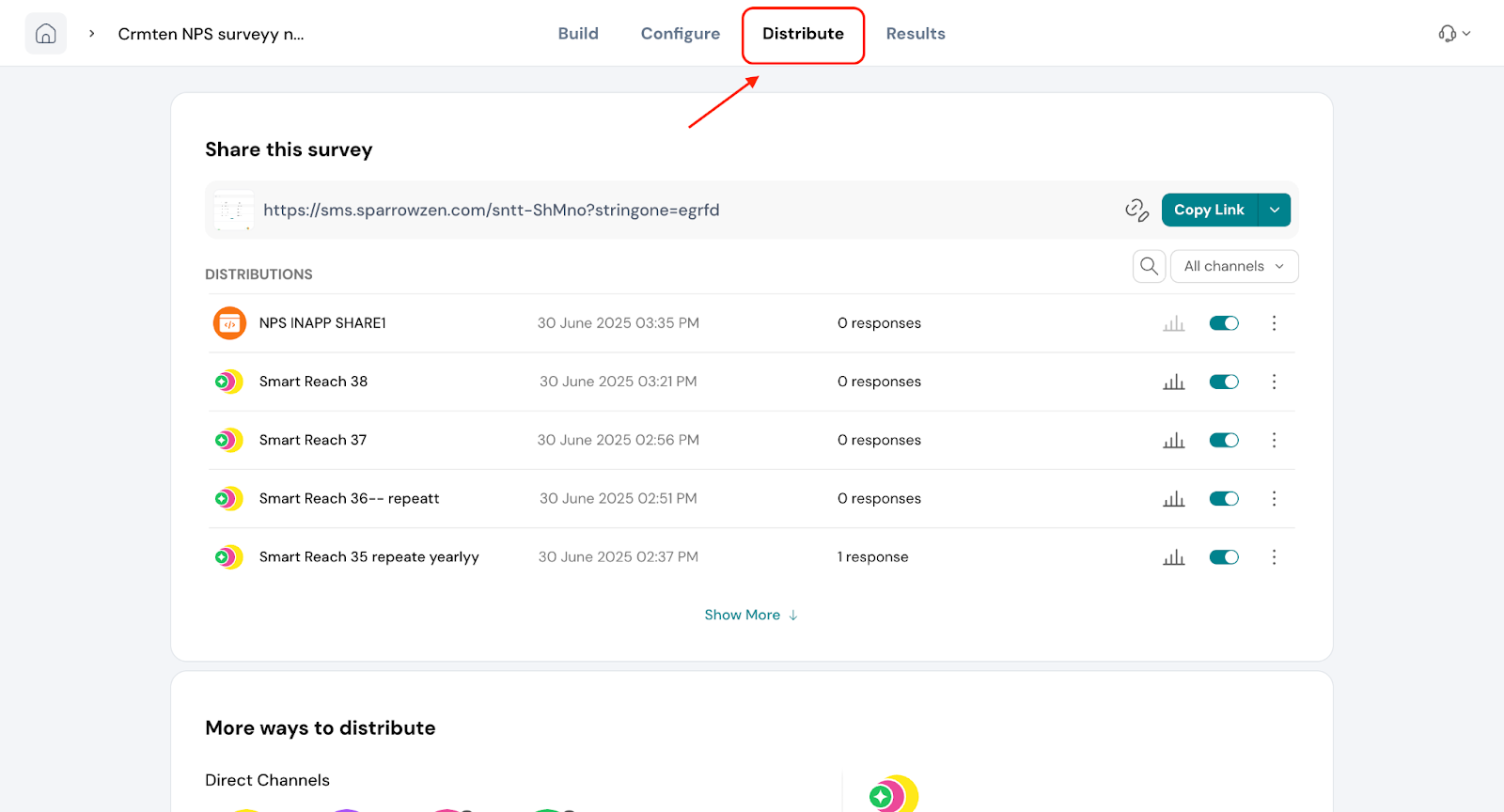
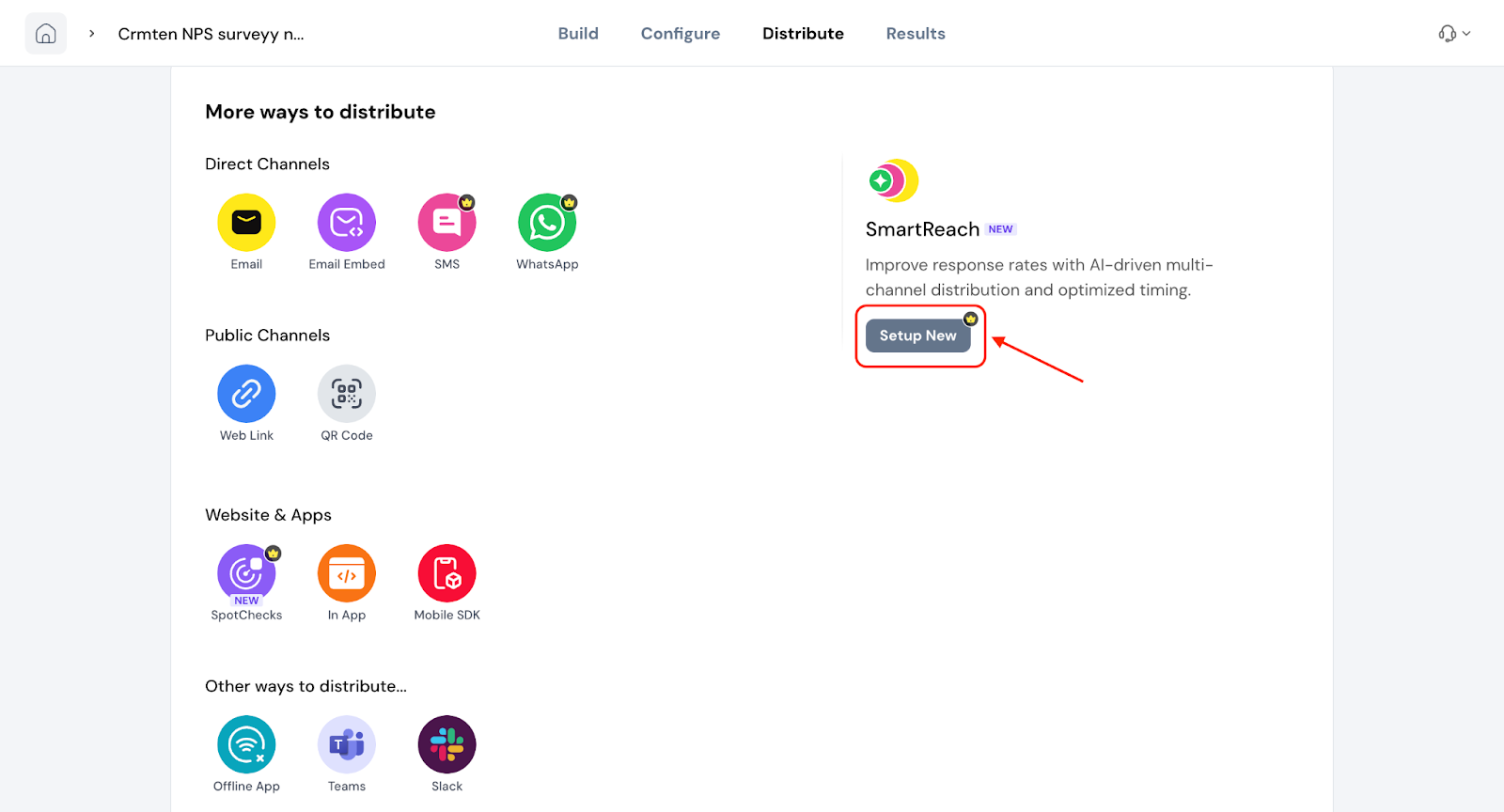
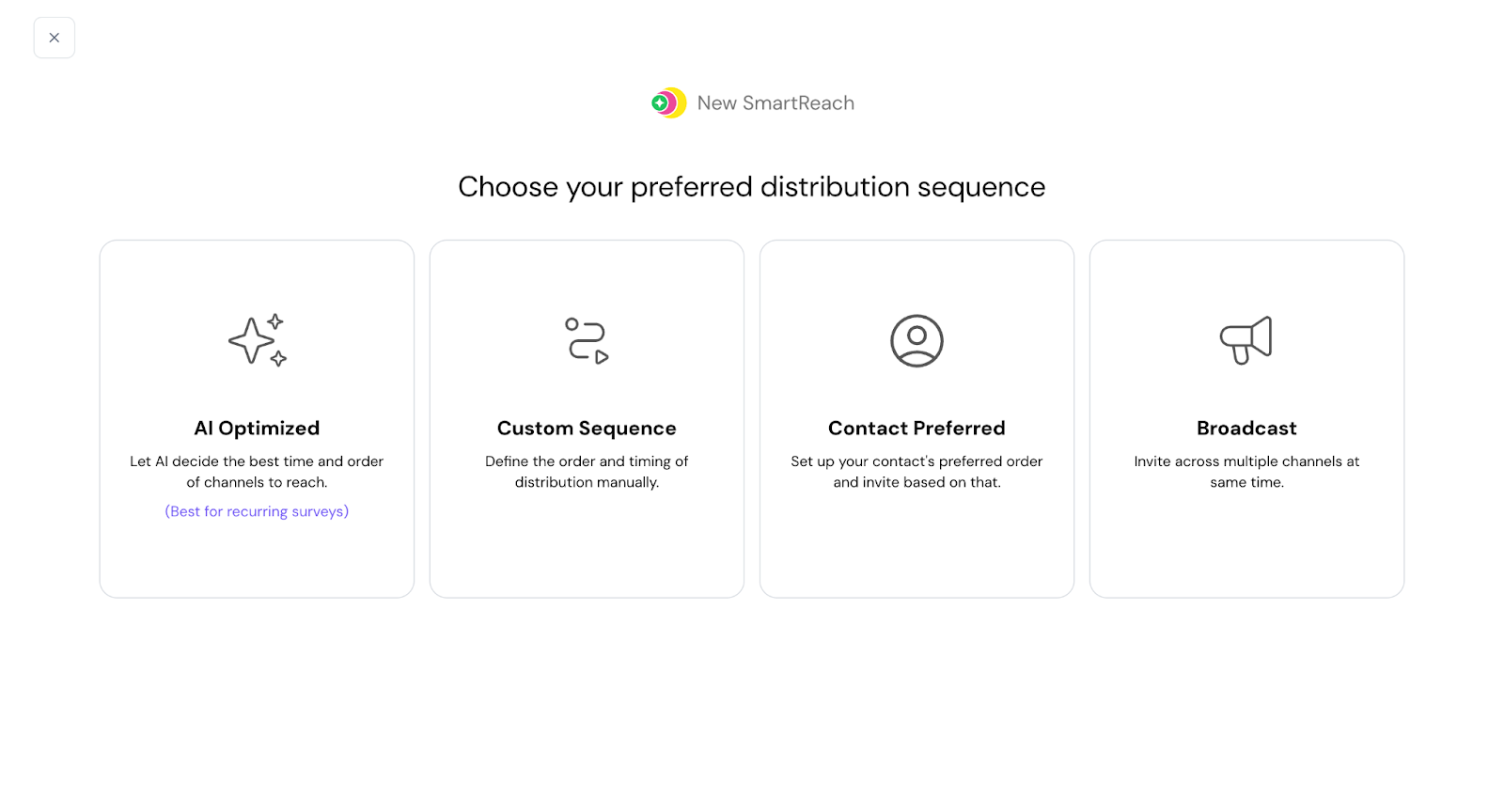
This mode lets SmartReach’s AI take full control. It automatically determines the best channel, whether that’s Email, SMS, or WhatsApp and the most effective time to send the survey, based on each contact’s past behavior and engagement history.
Over time, the AI learns and adapts, continuously improving its decisions to get better results. This option works especially well for large-scale, recurring campaigns where consistency and performance matter most, and where manual setup would be too time-consuming.
Example- A retail brand wants to collect feedback after customers complete an online or in-store purchase. Instead of manually segmenting the audience or guessing the right time to send surveys, the team enables AI Optimized mode in SmartReach. The system automatically decides whether to send the survey via Email, SMS, or WhatsApp, depending on each customer’s past response behavior.
For instance, a shopper who usually checks emails in the morning gets the survey then, while another who tends to respond on WhatsApp in the evening receives it accordingly. As the AI learns from each interaction, delivery timing and channel selection become even more precise, helping the brand gather richer, more reliable CX insights at scale, without manual effort.
1. Enter a title for the SmartReach.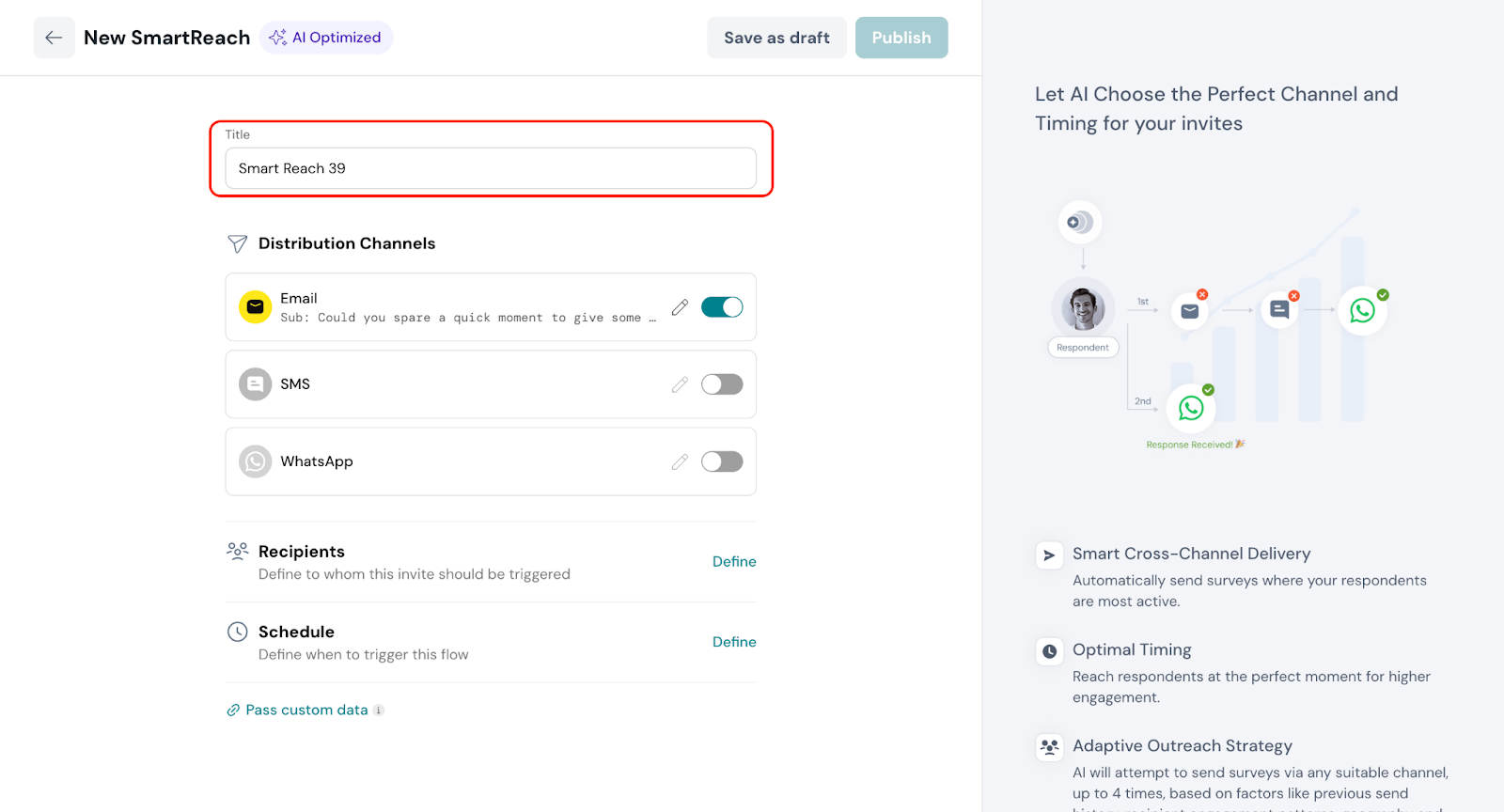
2. Choose the Distribution Channel: You can select one or more channels—Email, SMS, and WhatsApp. If you choose all three, SmartReach’s AI will determine the optimal channel and time for each recipient. By default, Email is selected.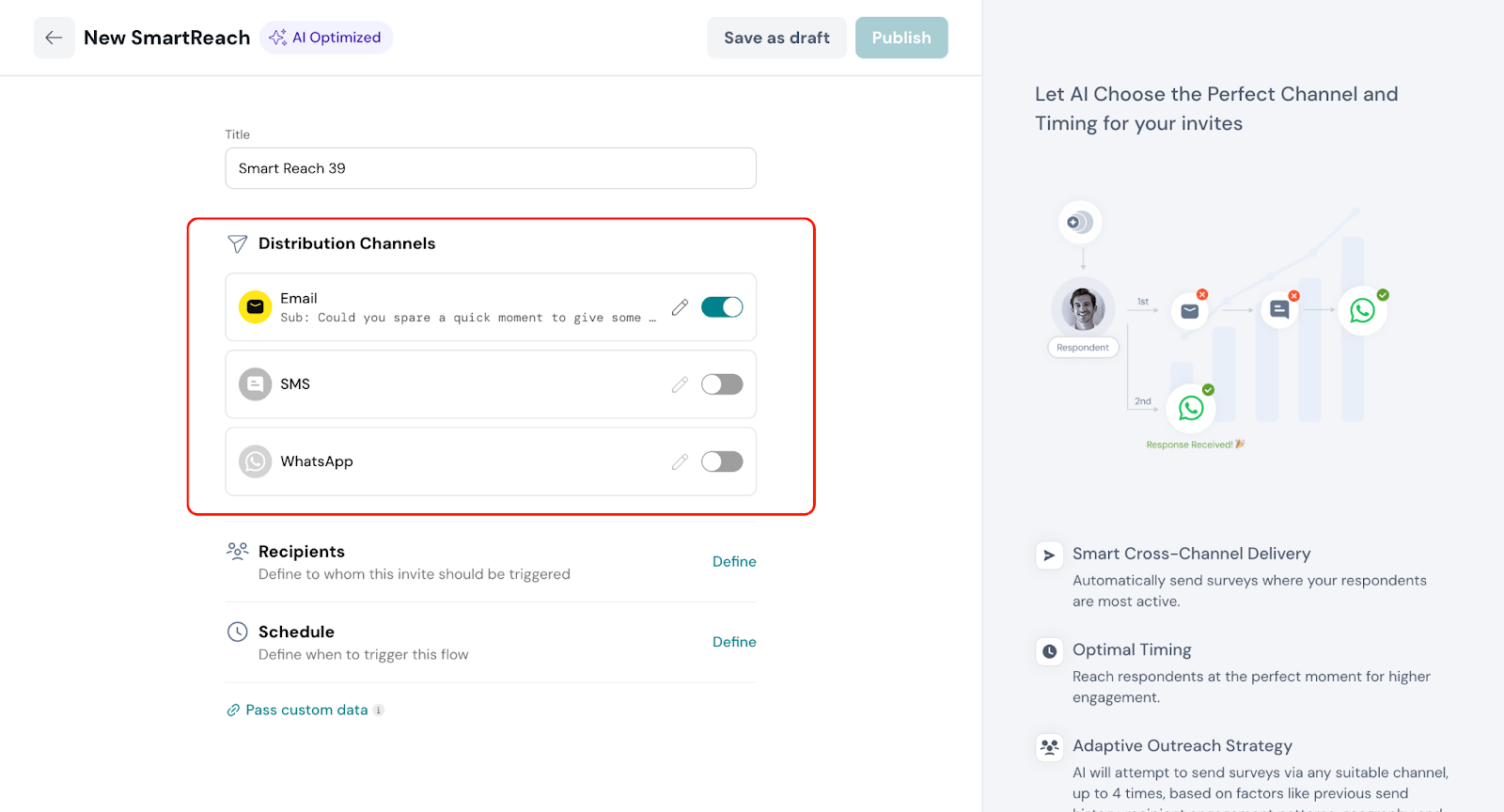
3. You can choose SMS as a channel, but you'll need to select a provider first. After selecting the provider, you can edit the message and use variables to personalize it. Once you're done, click Save SMS to apply the changes.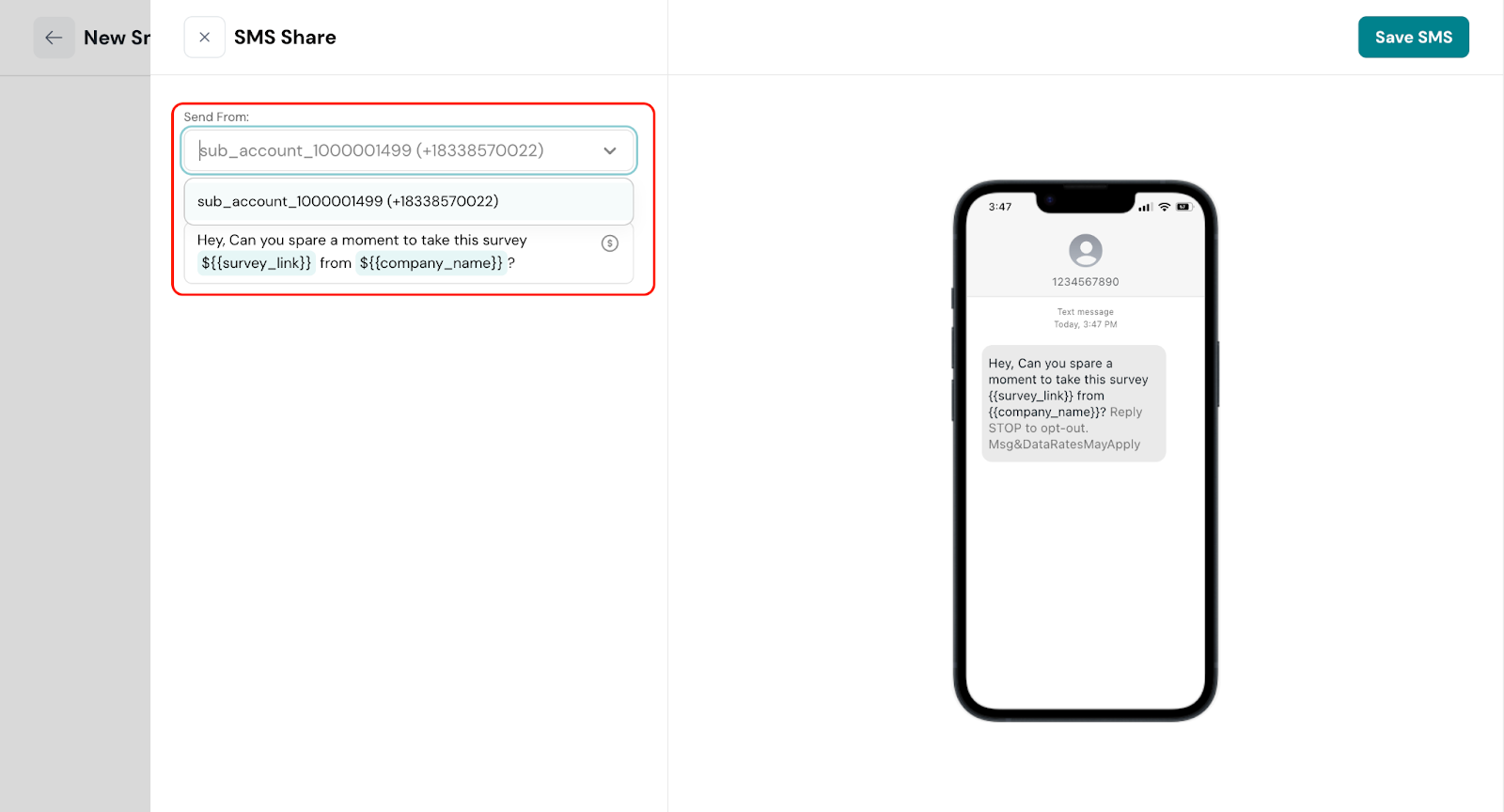
4. Choose WhatsApp:To configure WhatsApp as a channel, select a provider and choose a template. For more on templates, refer to this article on WhatsApp Templates.
Note: WhatsApp messages are sent based on your available wallet balance. Learn more in this article on WhatsApp Onboarding.
Once everything is set, click Save WhatsApp.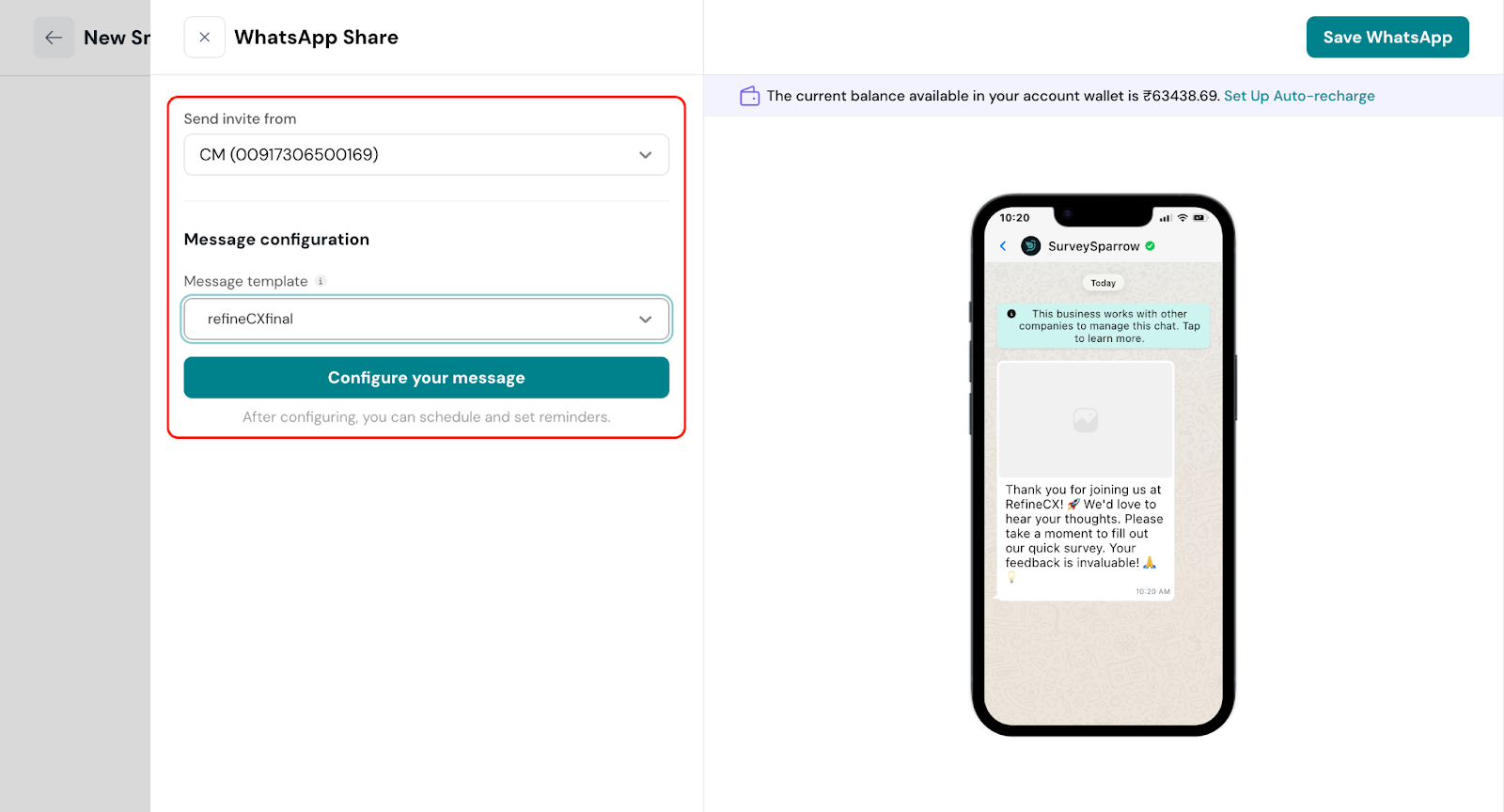
5. Recipients: Select the contact list you want to send the survey invite to. To do this, click the dropdown menu and choose the desired list.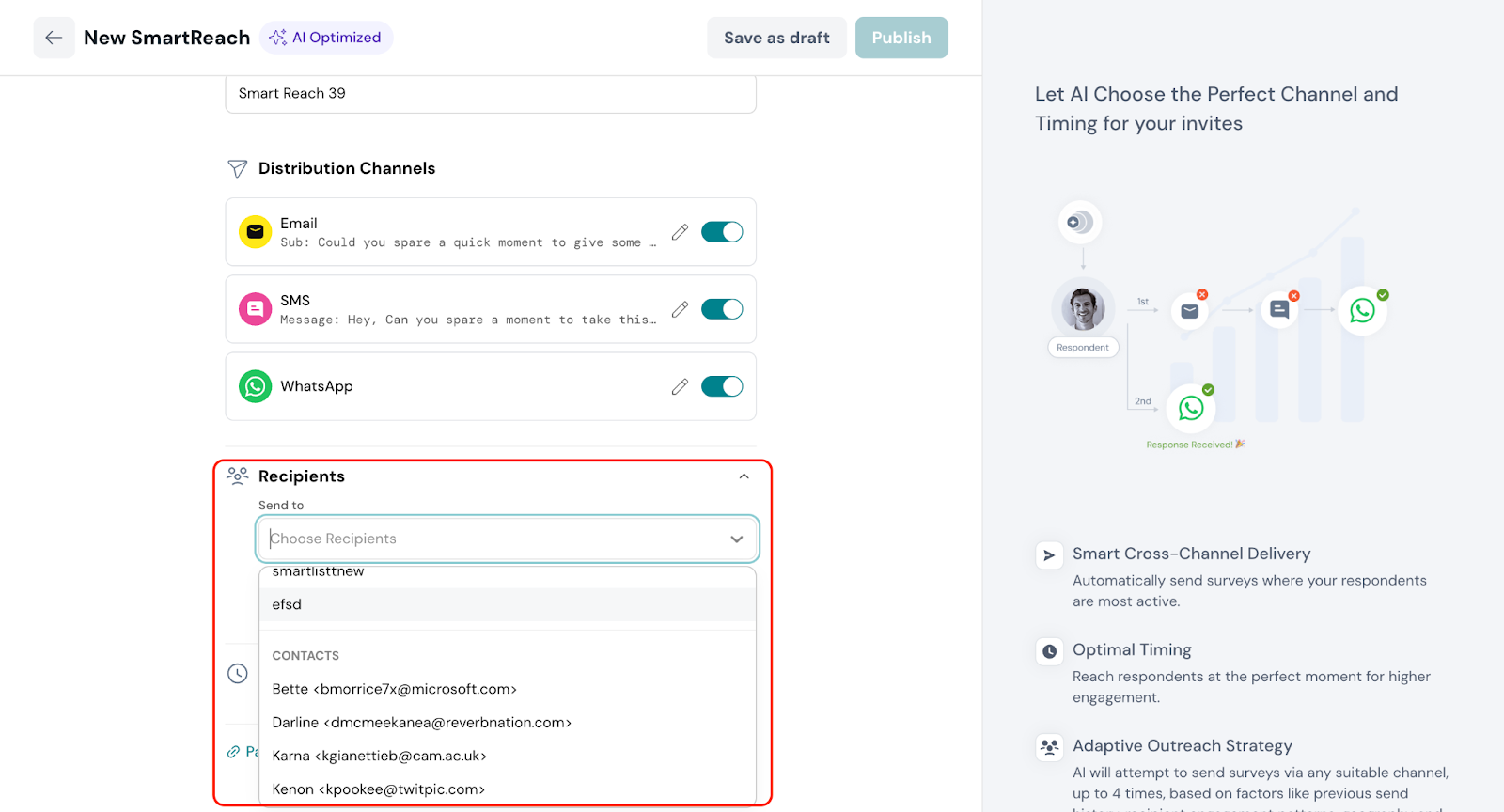
You can also choose to import the contacts via a CSV.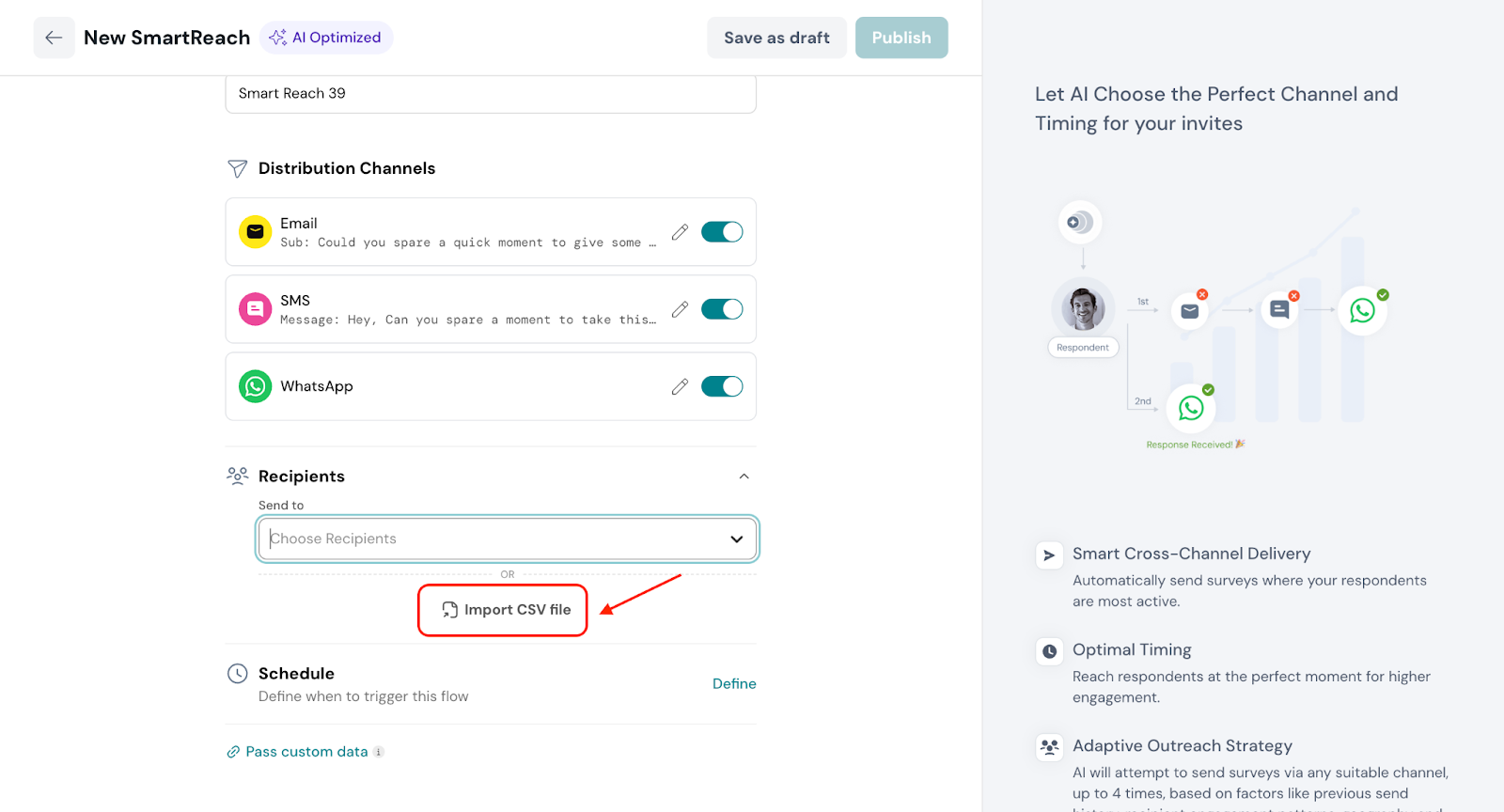
6. Schedule: Under the schedule section, you can choose from three options based on your campaign needs. You can send the survey today at the best time, schedule it for a specific day at the best time, or trigger the survey based on defined conditions. These options give you flexibility to align survey delivery with user behavior or specific business events.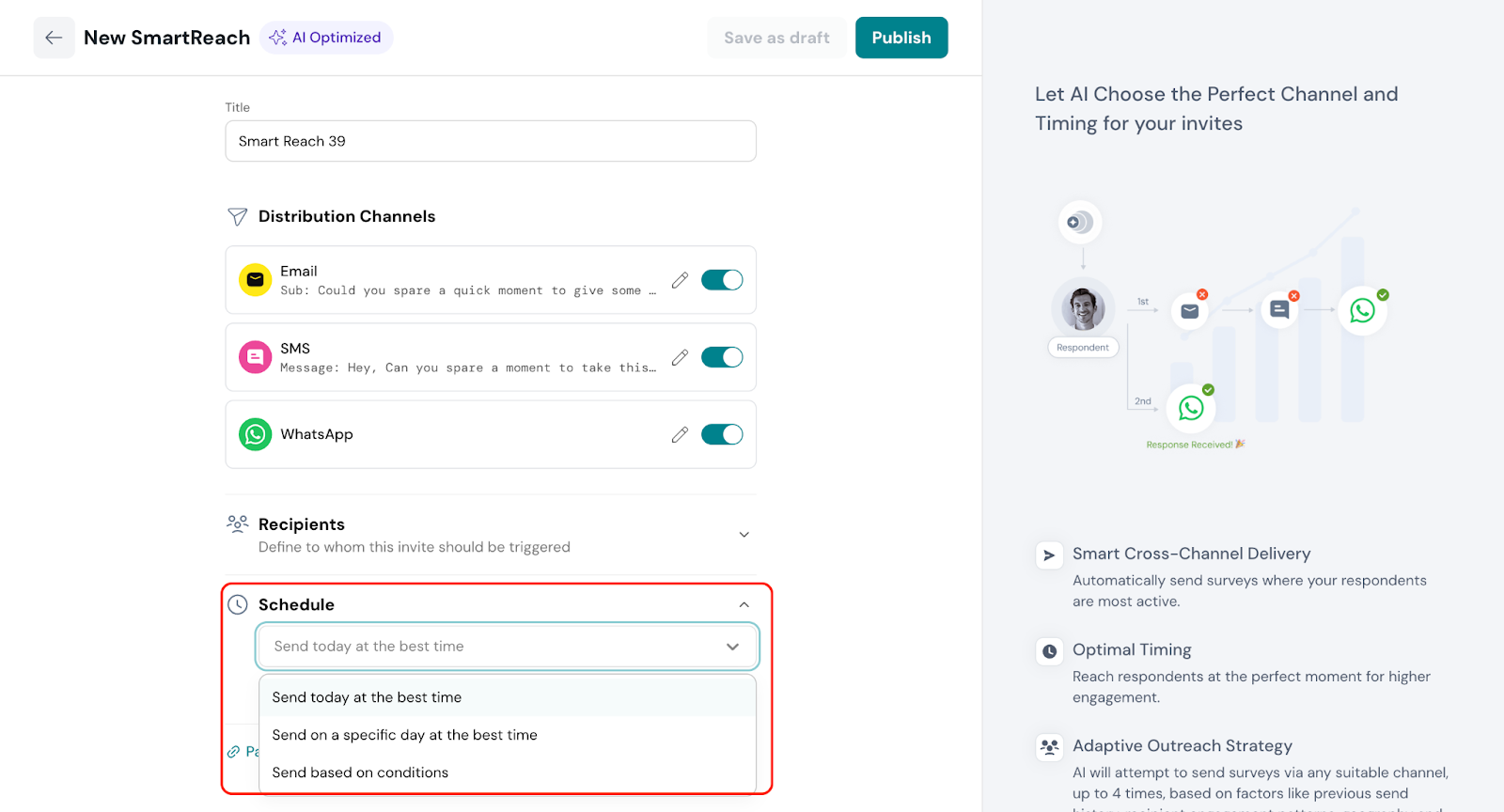
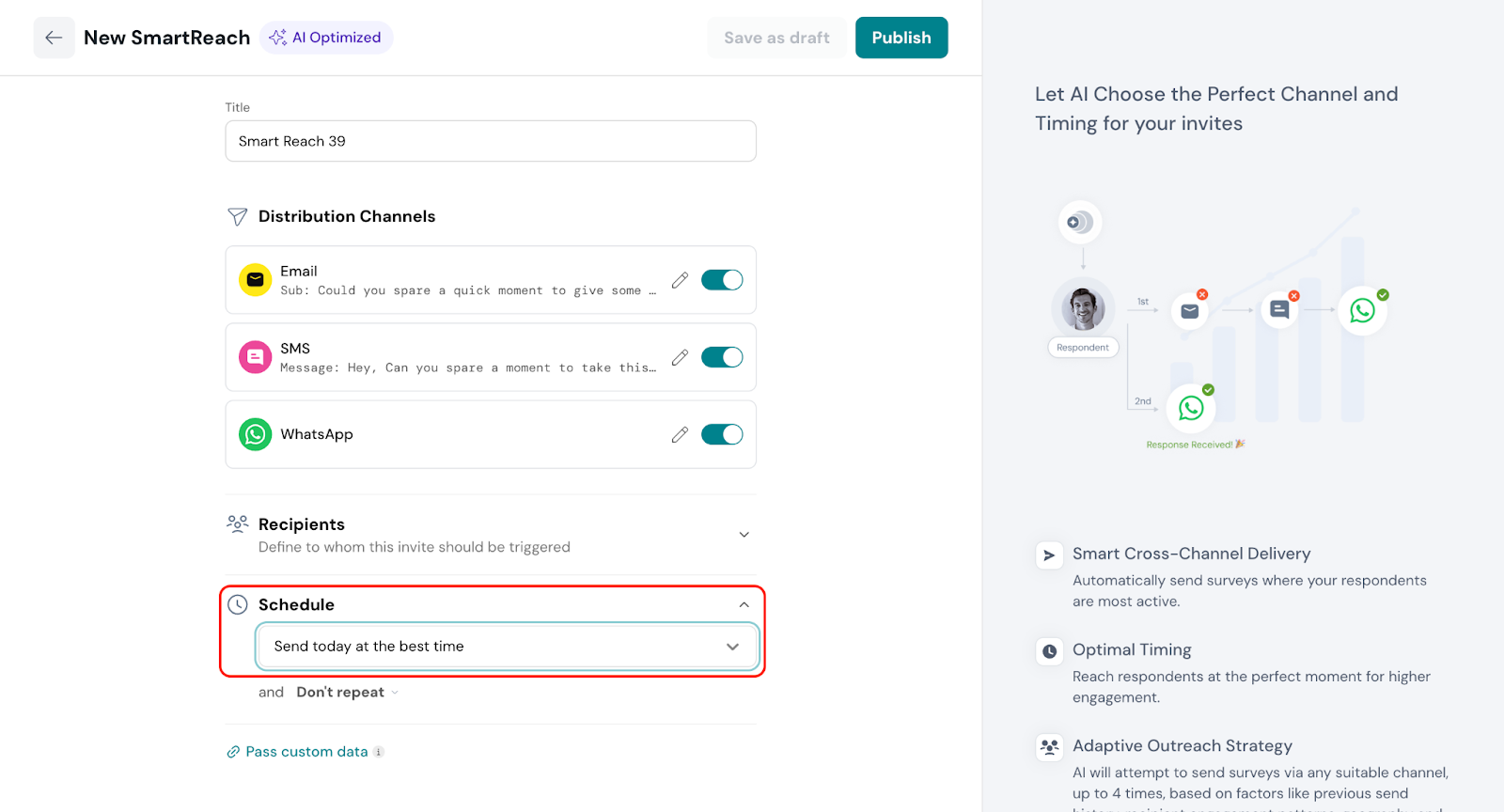
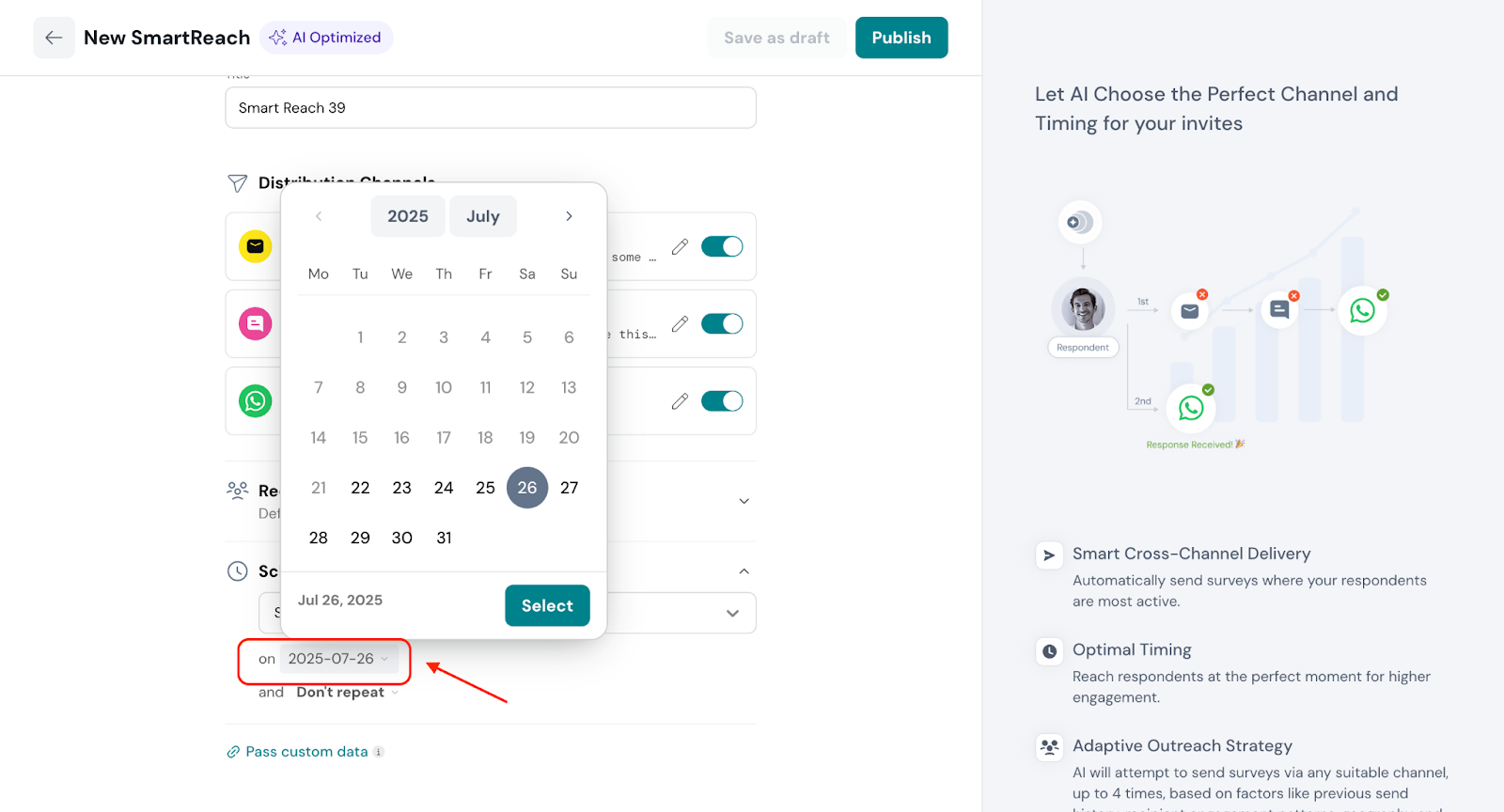
If you choose Repeat, you’ll need to specify the recurrence period. You can set the survey to repeat daily, weekly, monthly, quarterly, or yearly depending on your campaign needs. This helps automate ongoing feedback collection over time.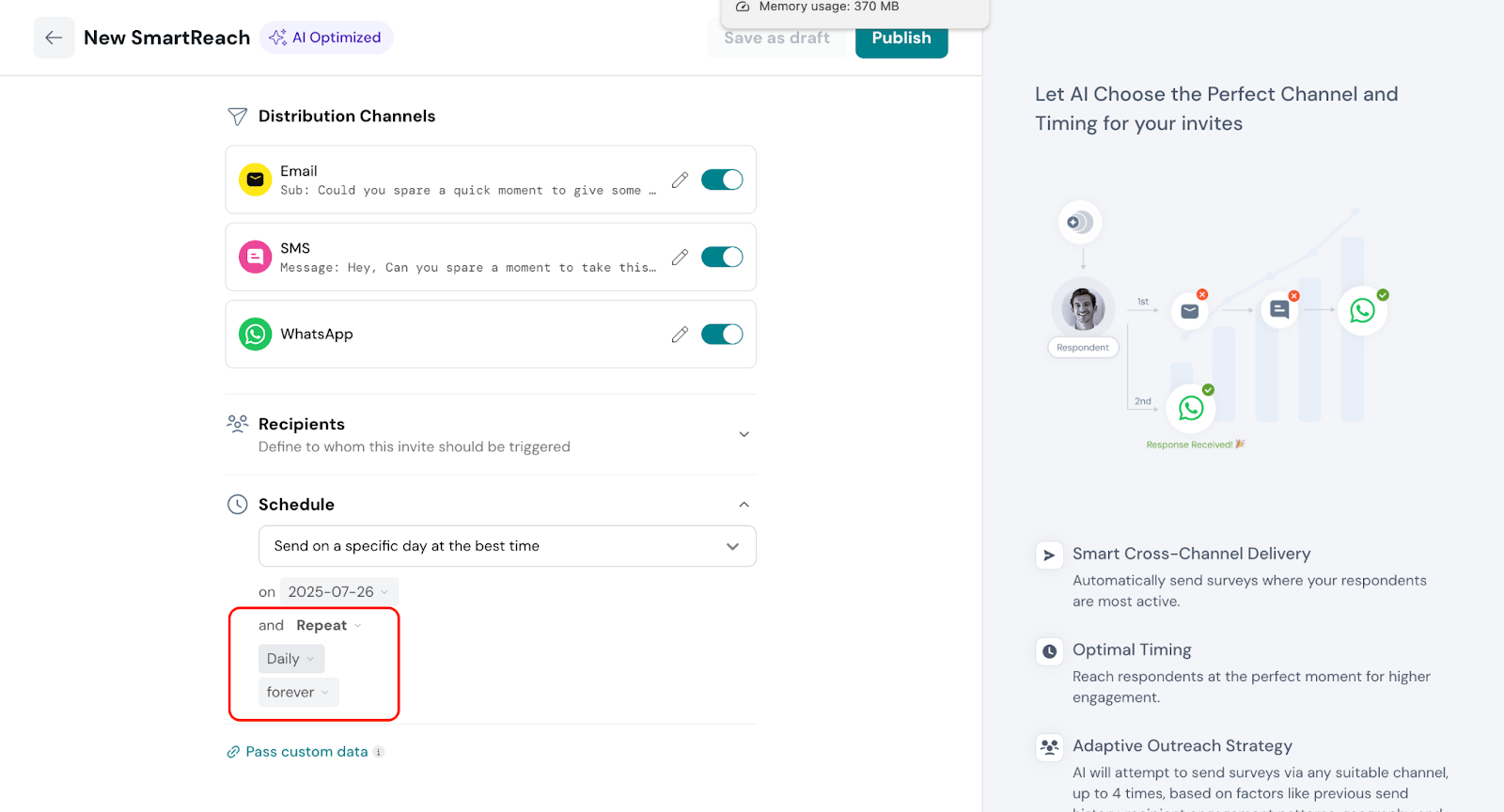
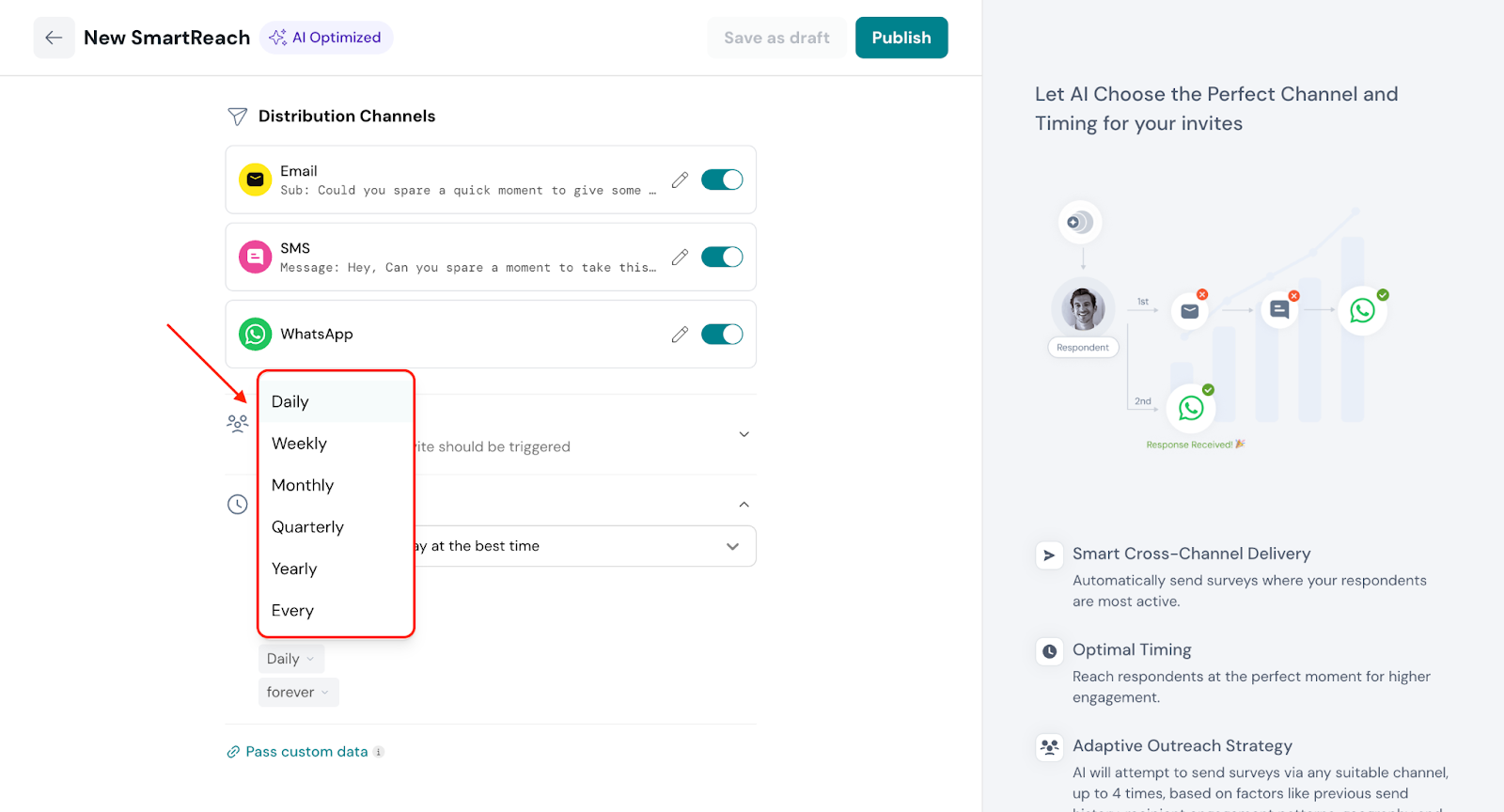
You will also see an "Every" option, which allows you to trigger the survey at more specific intervals such as a particular hour, day, or week, giving you even greater control over how frequently the survey is sent.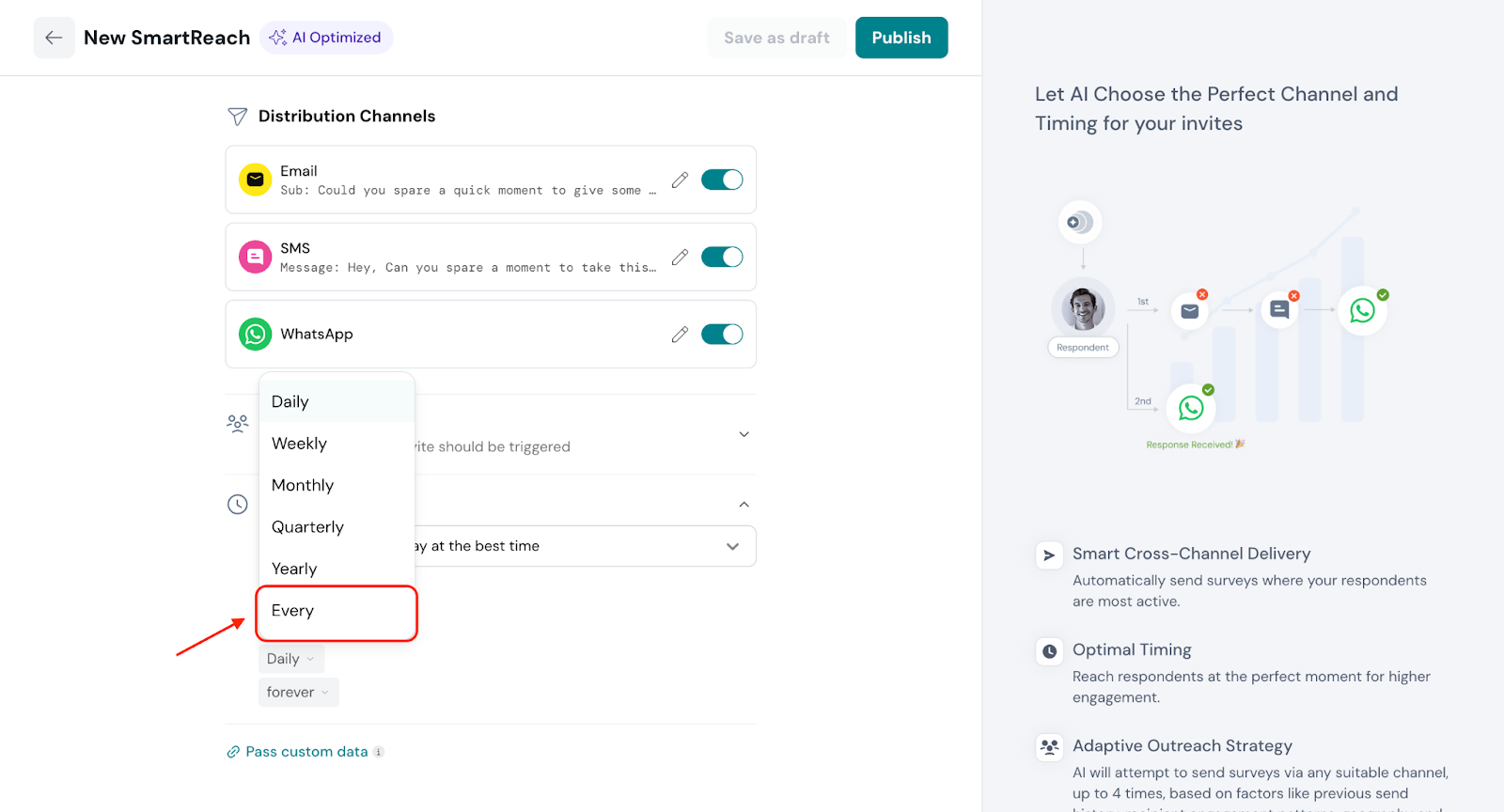
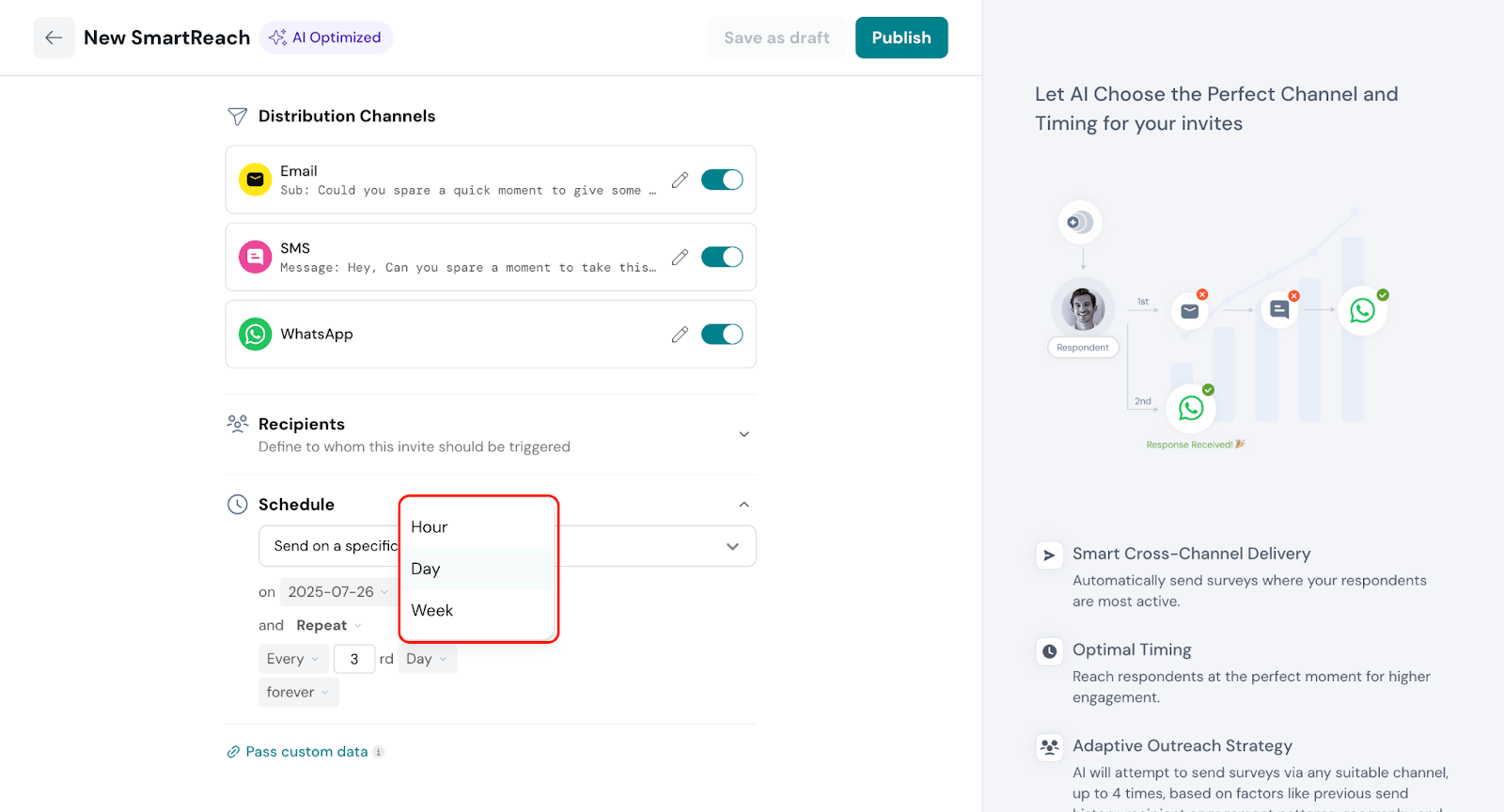
You can also set the occurrence frequency to control how long the survey should repeat. There are three options:
End after ‘x’ occurrences: The survey will stop automatically after it has been sent the number of times you specify. This lets you set a clear limit on how many times the survey goes out.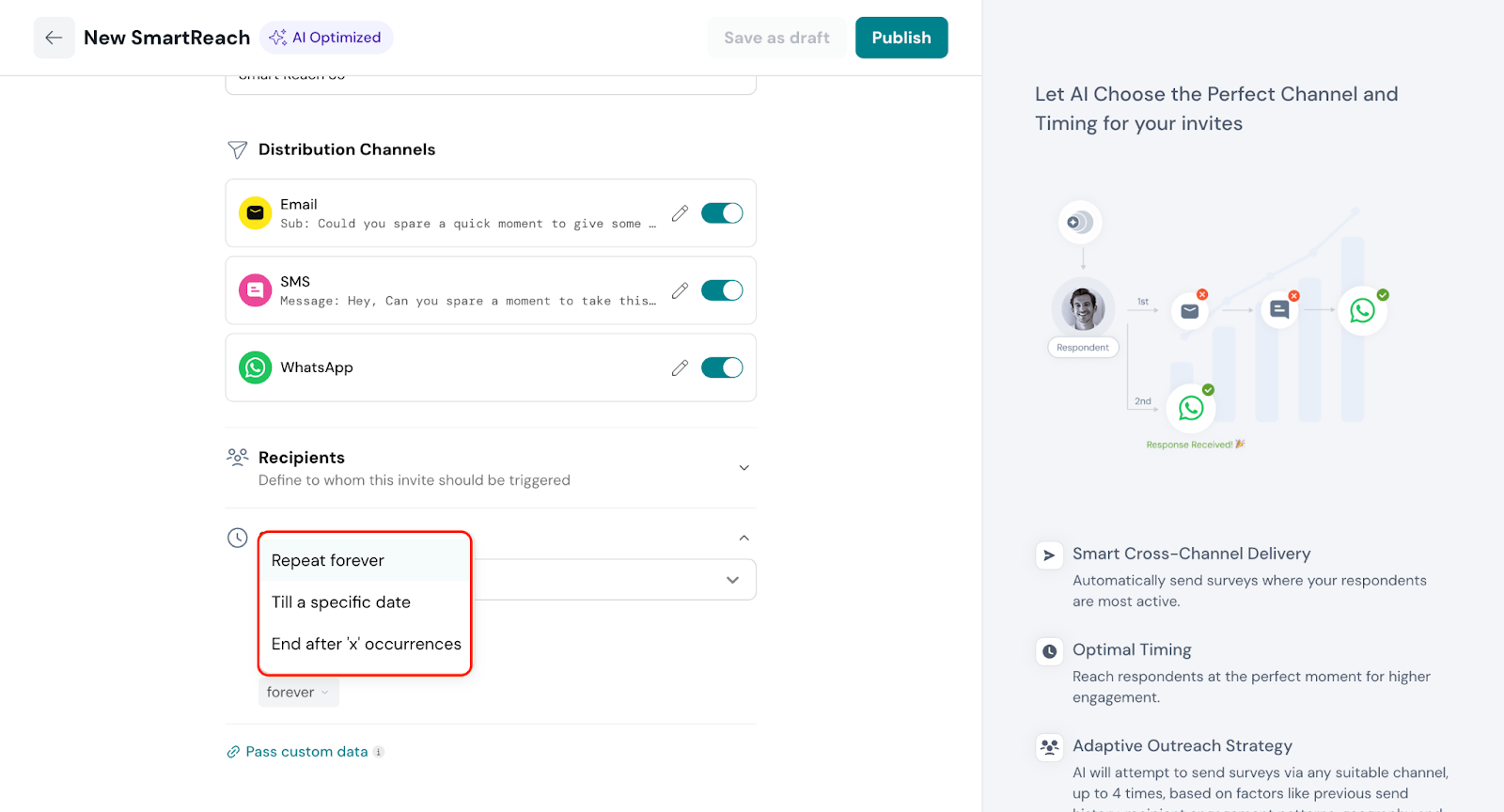
Note: The survey will continue to be sent to your audience until they respond. For example, if you choose “Send today at the best time,” SmartReach will attempt delivery at the most optimal times throughout the day until a response is received.
Survey Based on Conditions:
This option allows you to trigger surveys based on specific, user-defined conditions. For instance, you can choose to send a survey 5 days after a customer’s birthday, or after any other custom event. The survey will only be sent when the specified conditions are met, giving you full control over targeted, context-aware outreach.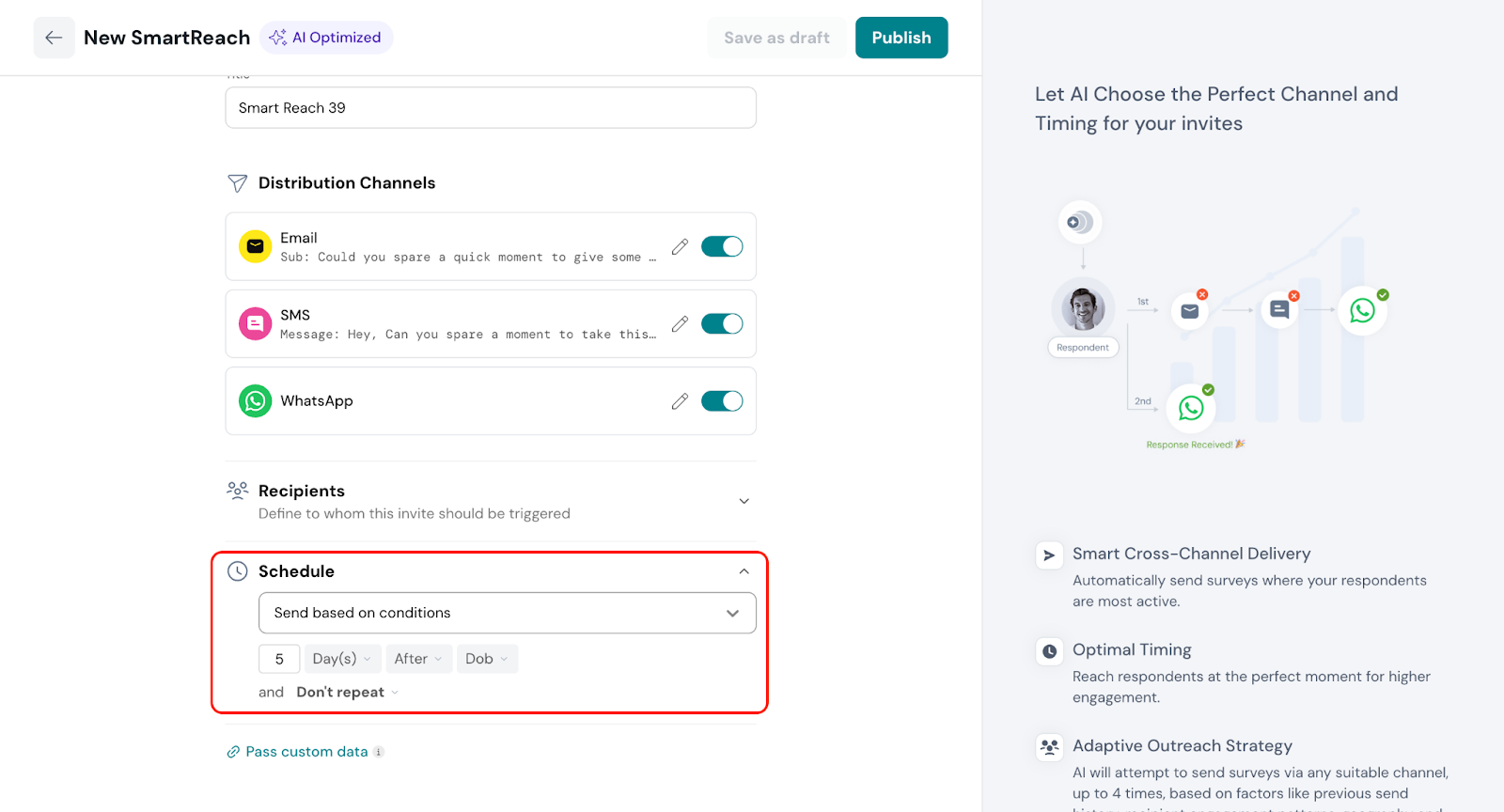
7. Pass Custom Data: You can personalize your surveys by adding custom variables, such as the recipient’s first name. This allows you to tailor the survey content for each individual, making your outreach more relevant and engaging.
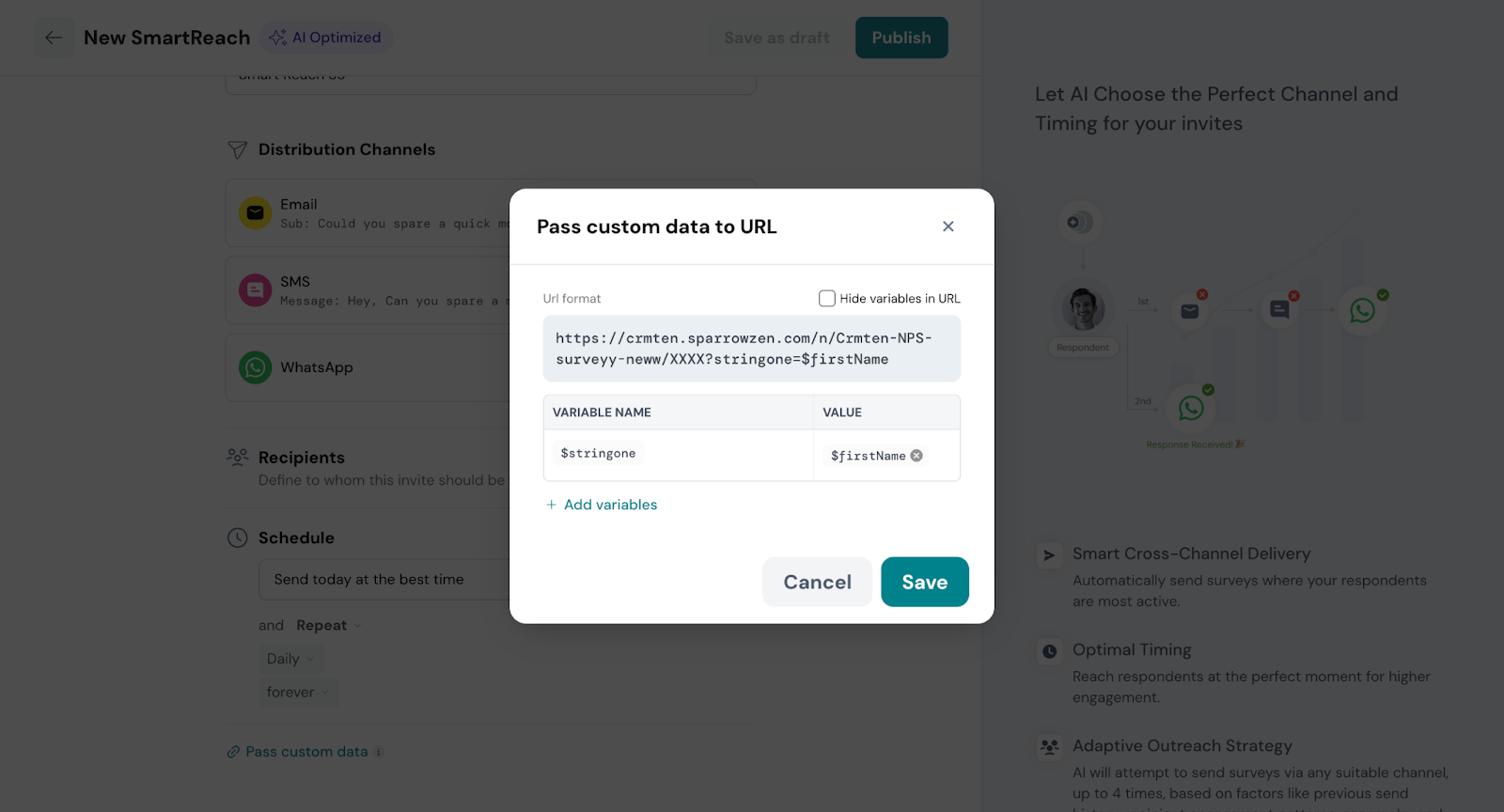
Note: You can also choose to hide variables in the URL to keep personal data secure and maintain a clean, user-friendly link.
In this mode, if you prefer to design your own outreach journey, Custom Sequence gives you full control. Using a visual drag-and-drop builder, you can create a personalized flow that matches your strategy. For example, you might choose to send an Email first, wait two days, and then send an SMS if there's no response. This option is ideal for teams that want precision in how and when messages are delivered, and for those who want to experiment with different touchpoints and timing rules.
Example- A hotel chain wants to collect guest feedback after each stay, but their guests vary in communication preferences and responsiveness. To create a more controlled and tailored experience, the CX team uses Custom Sequence mode in SmartReach.
They set up a flow that sends the first survey via Email shortly after checkout. If the guest doesn’t respond, the system waits 12 hours and sends a reminder via SMS. If the guest partially responds, another 12-hour delay is added before sending a final message via WhatsApp.
This structured outreach ensures timely and relevant follow-ups, adapting to the guest's level of engagement while giving the CX team full control over timing and communication flow.
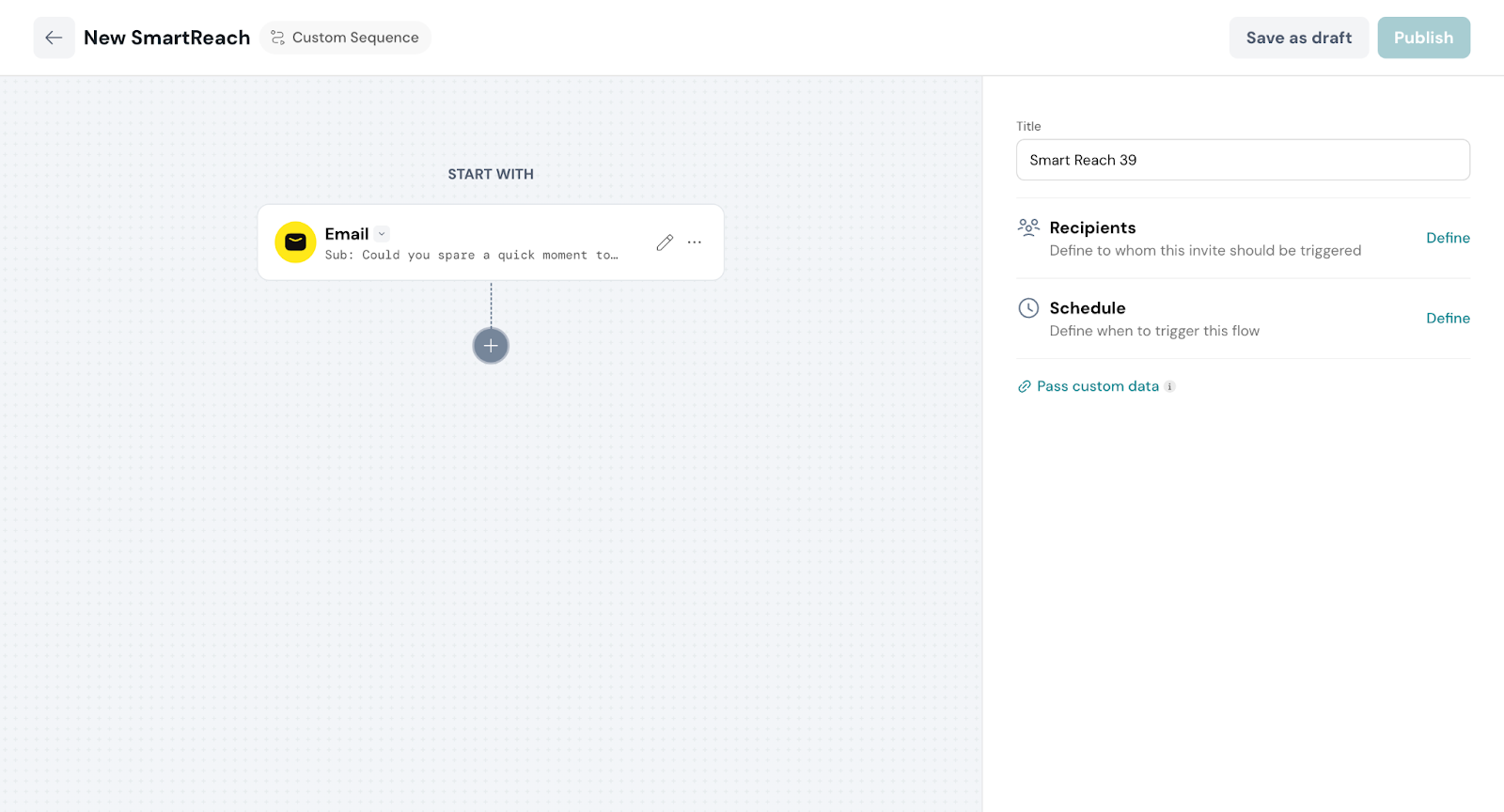
To do this, simply use the dropdown next to Email and select the channel of your choice: SMS or WhatsApp to start the sequence based on your preference.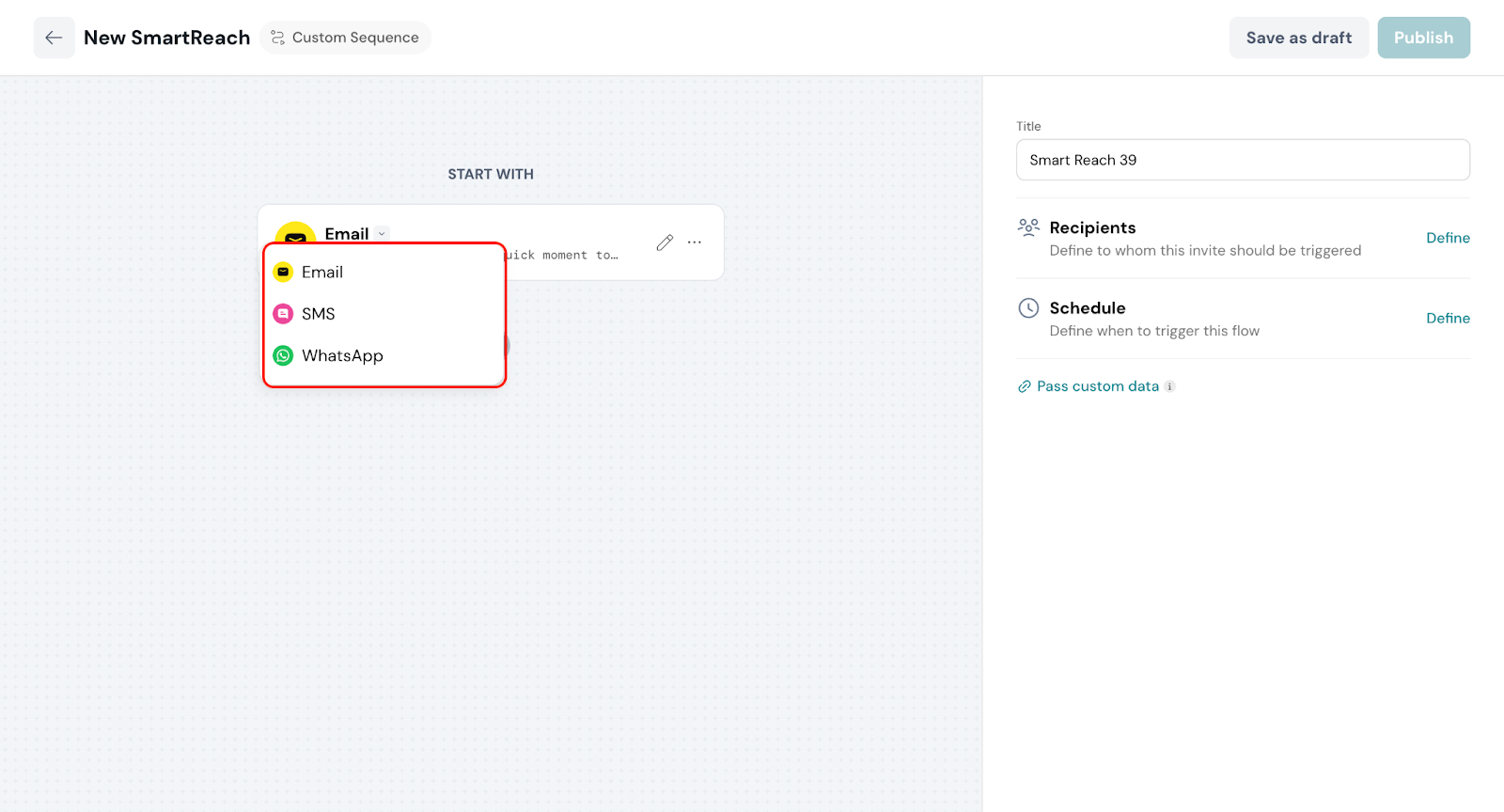
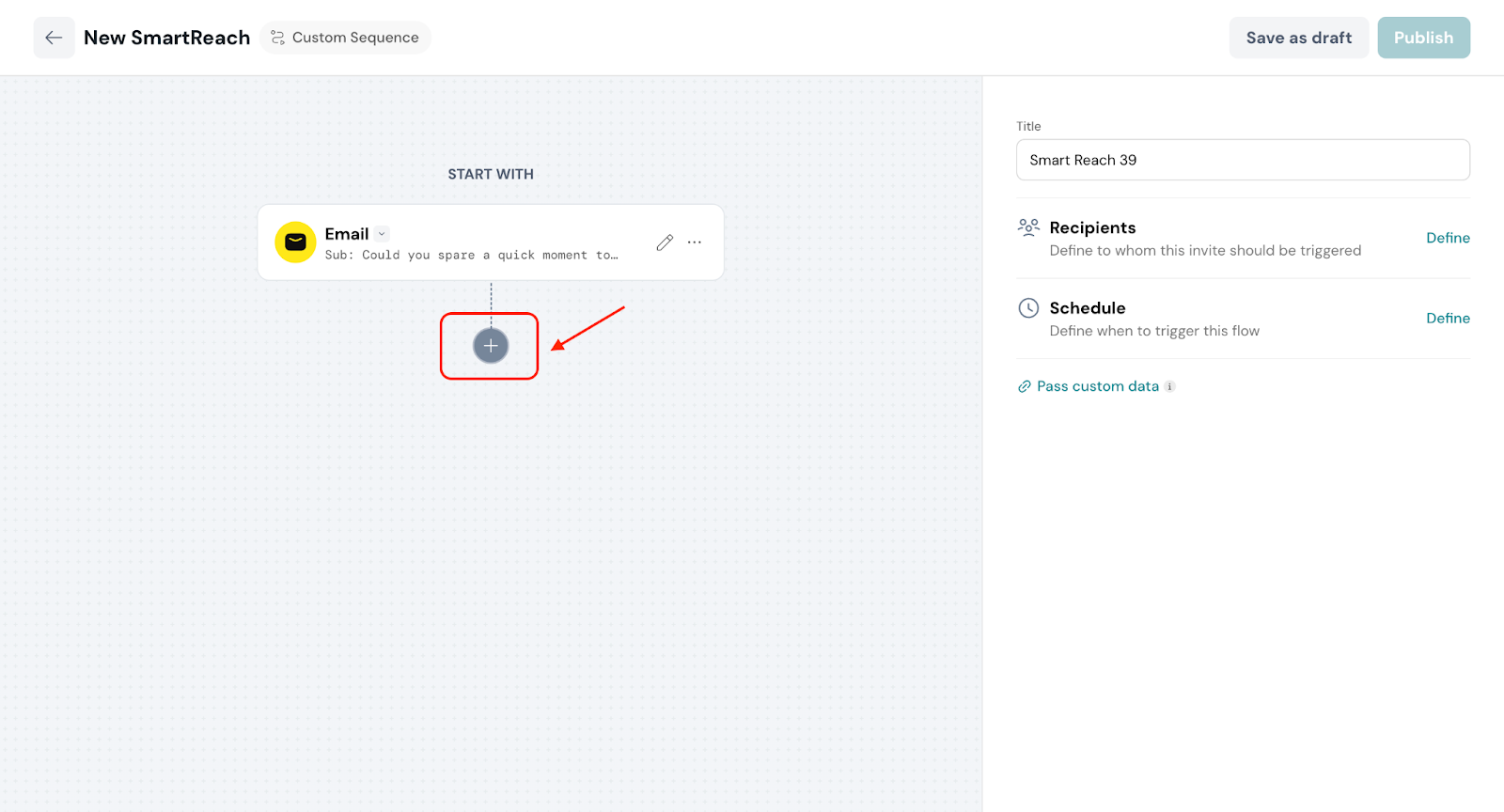
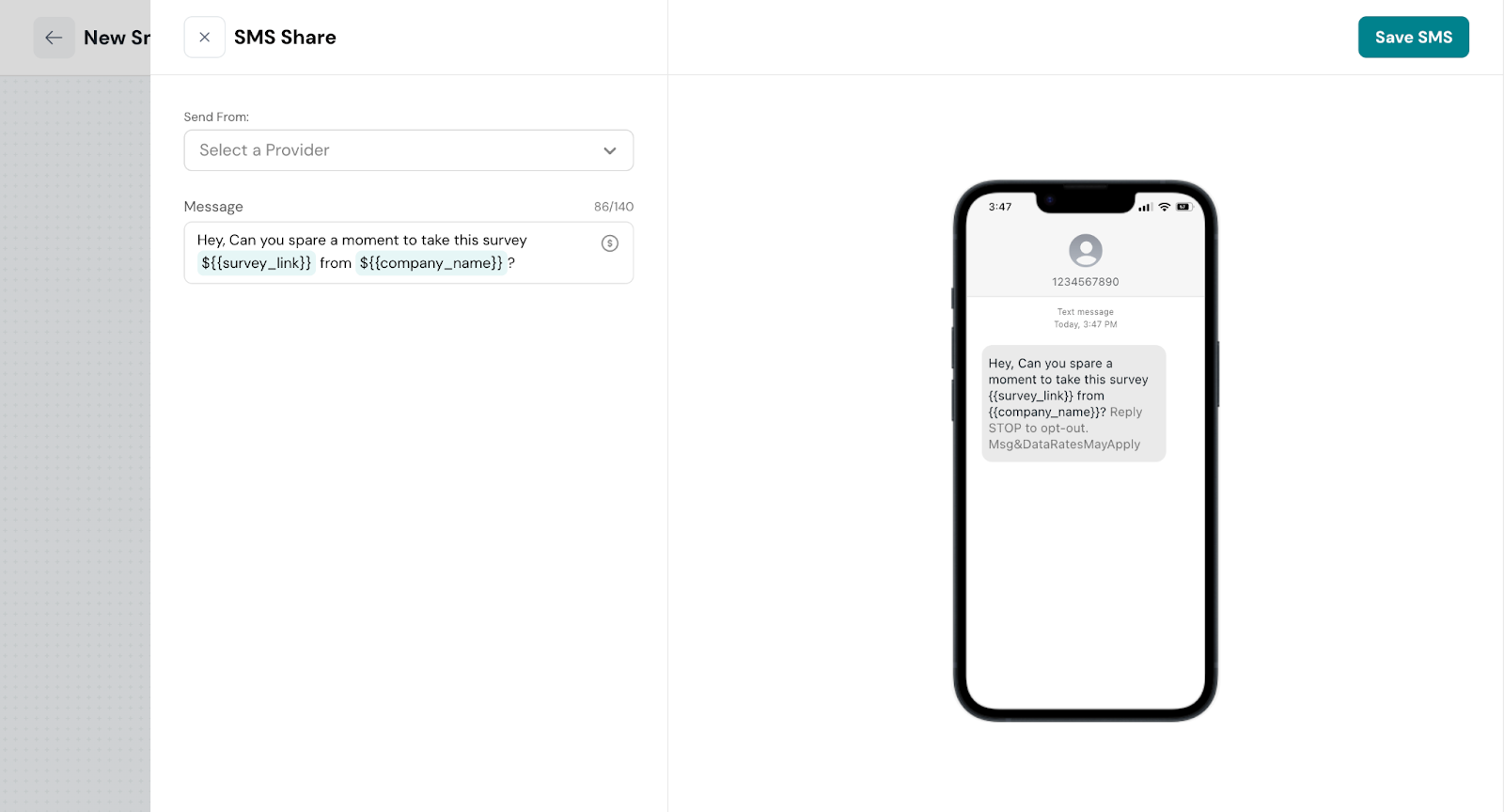
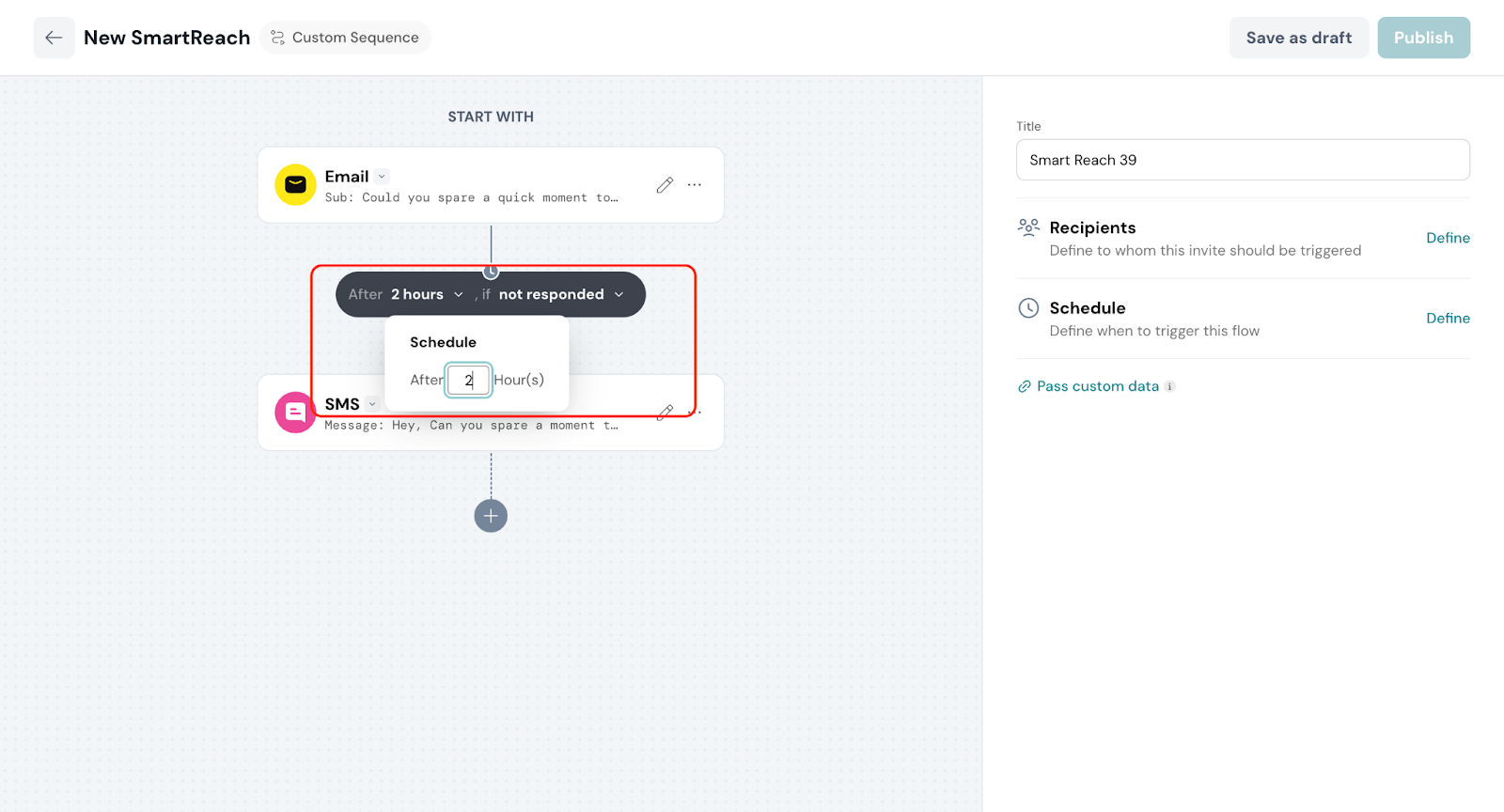
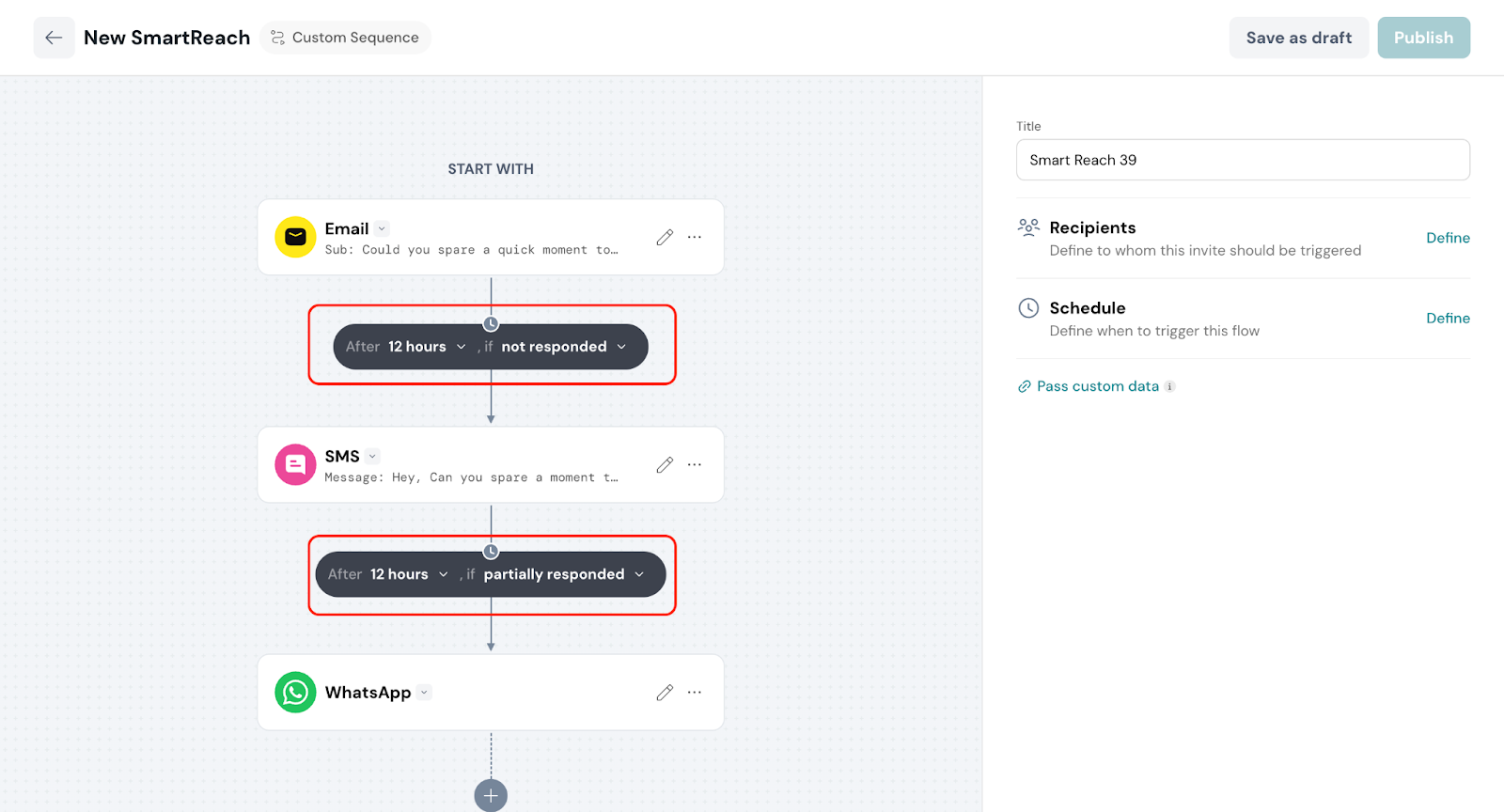
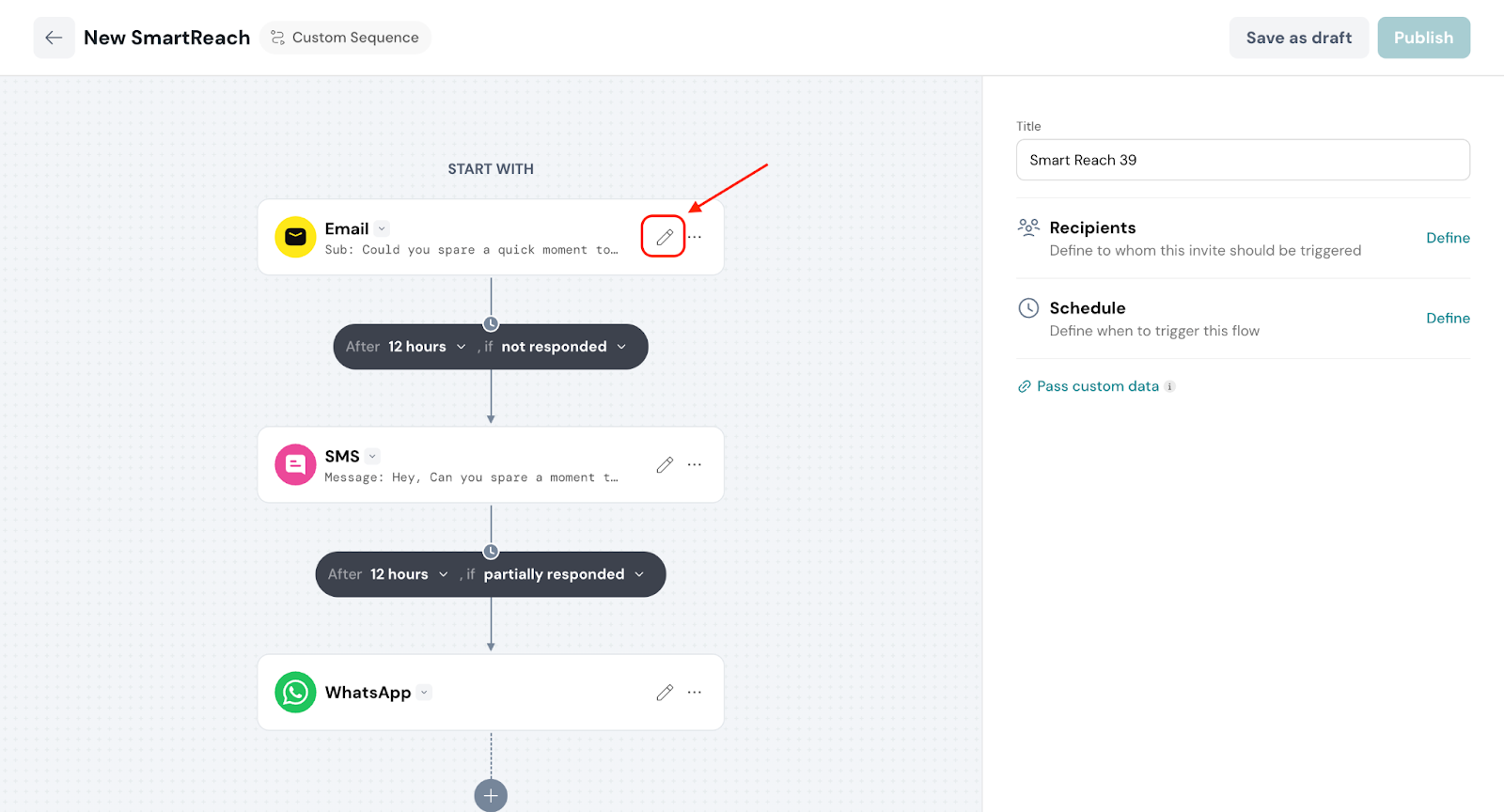
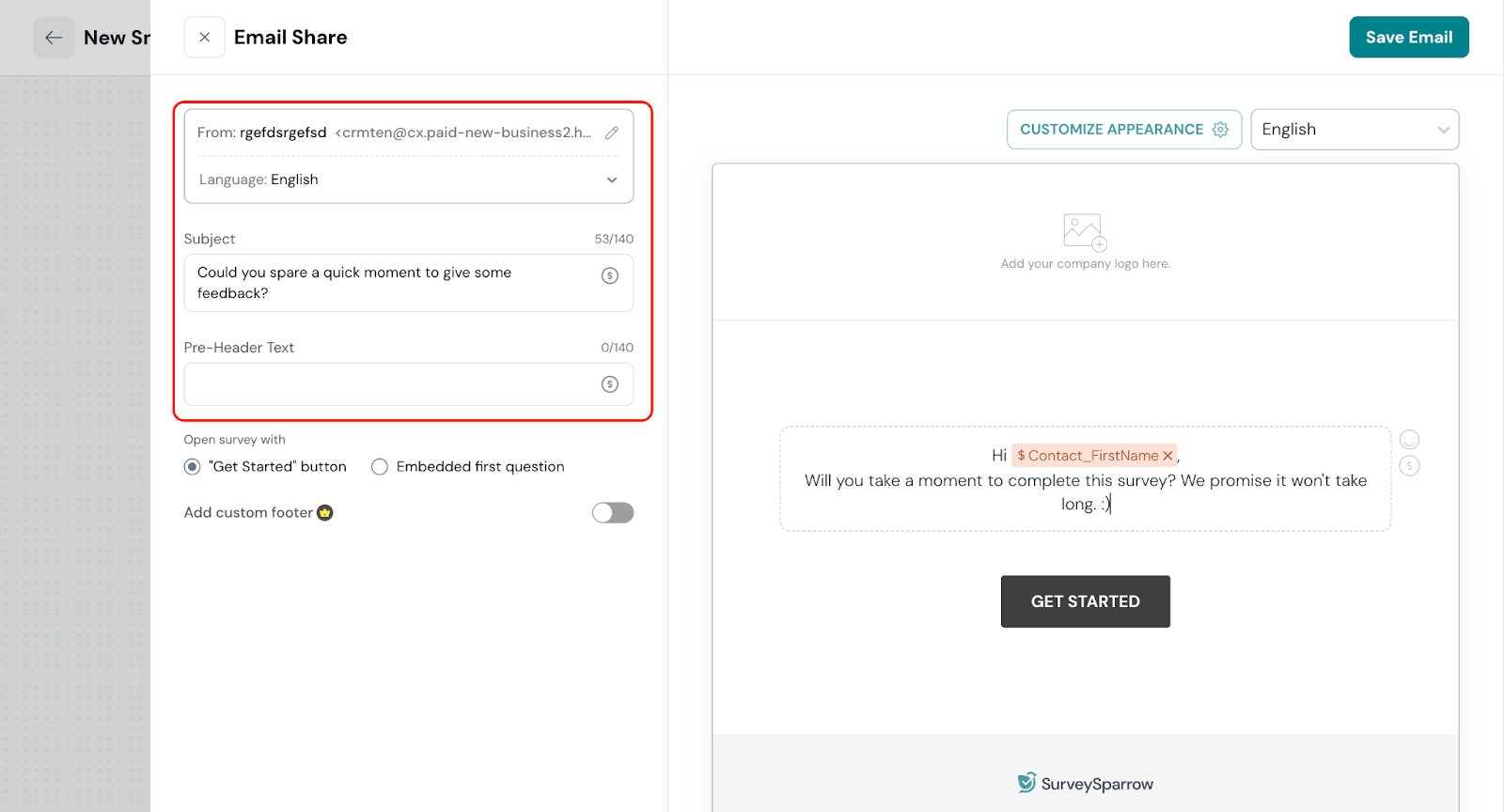
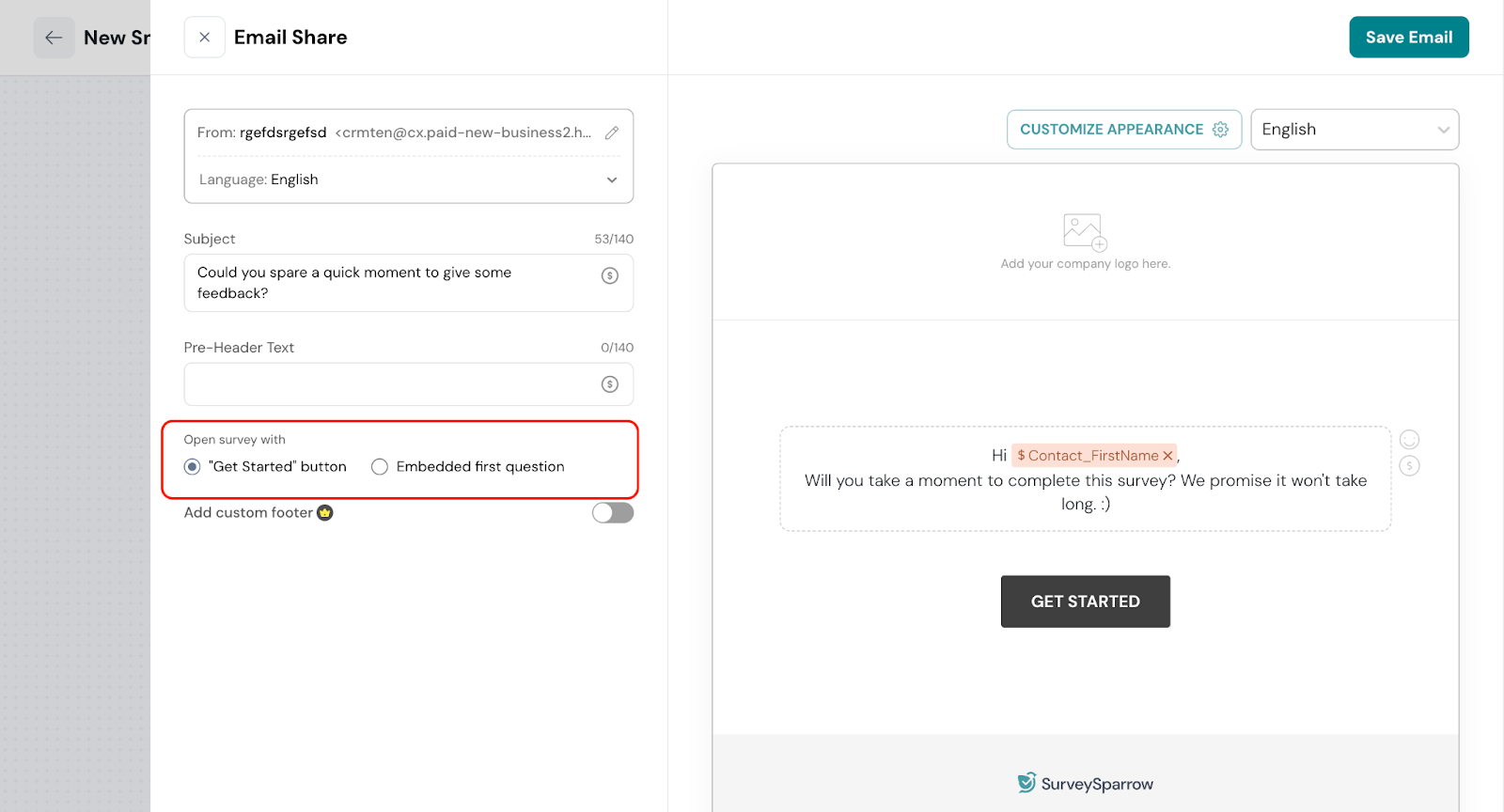
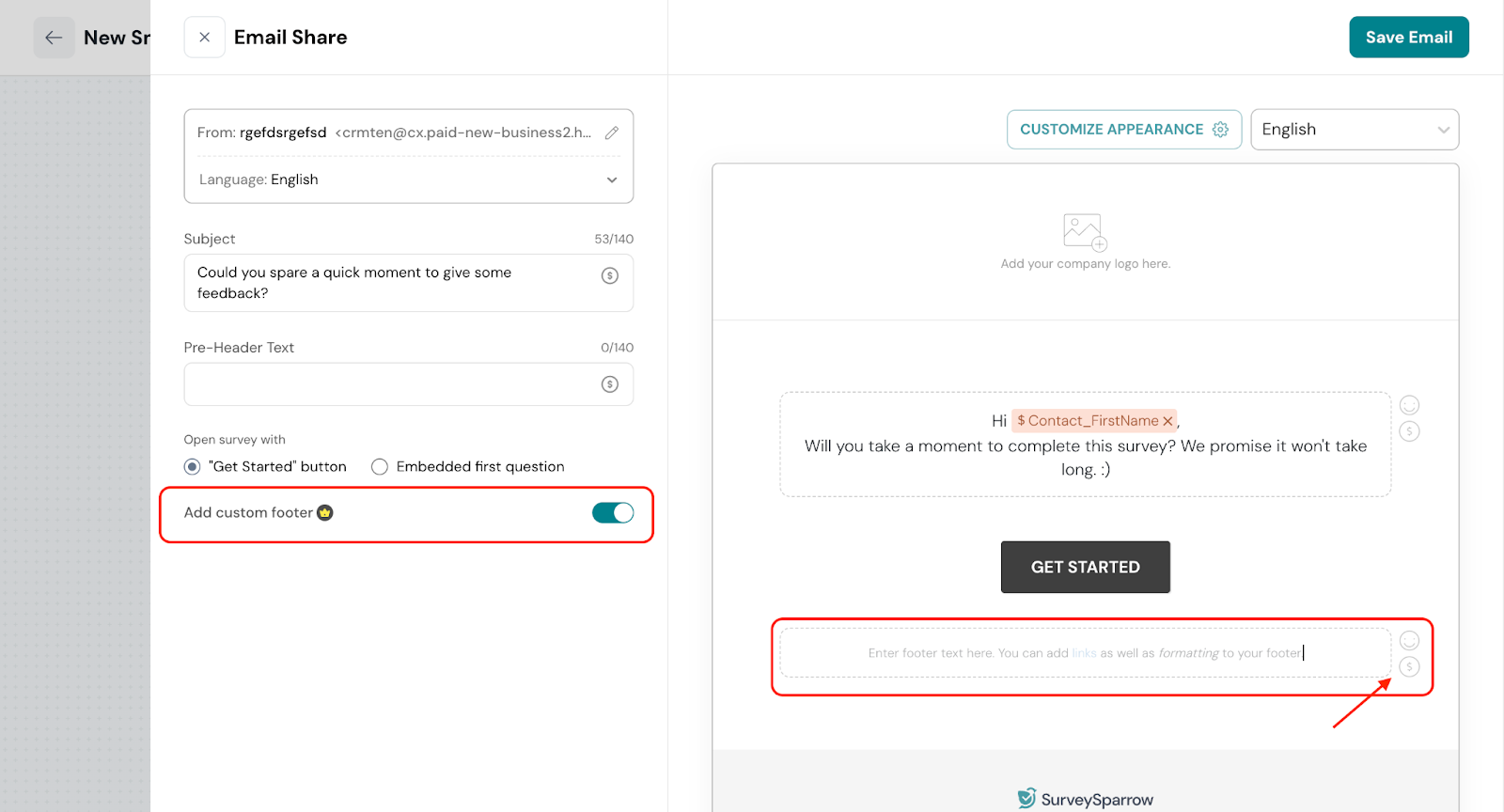
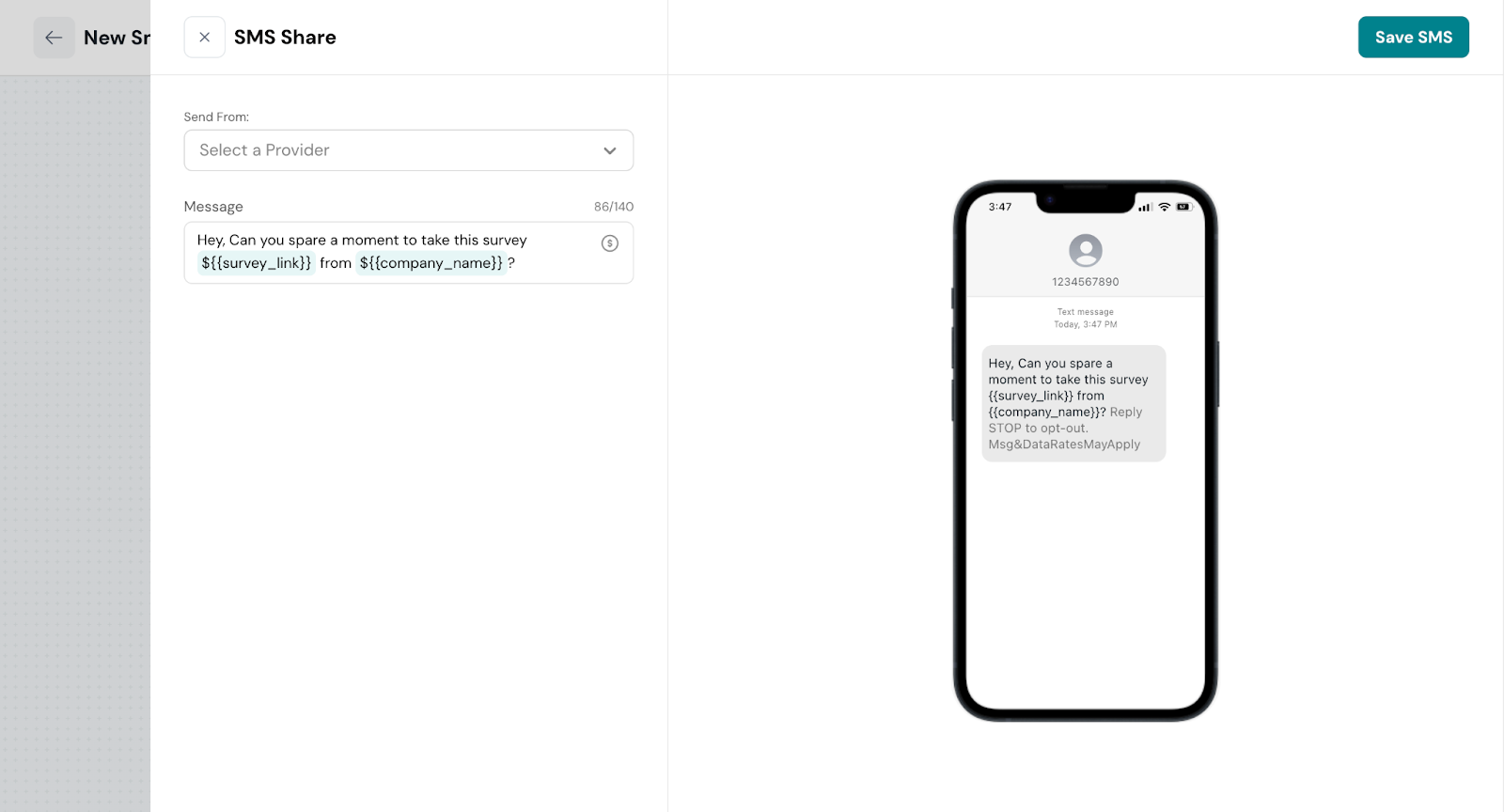
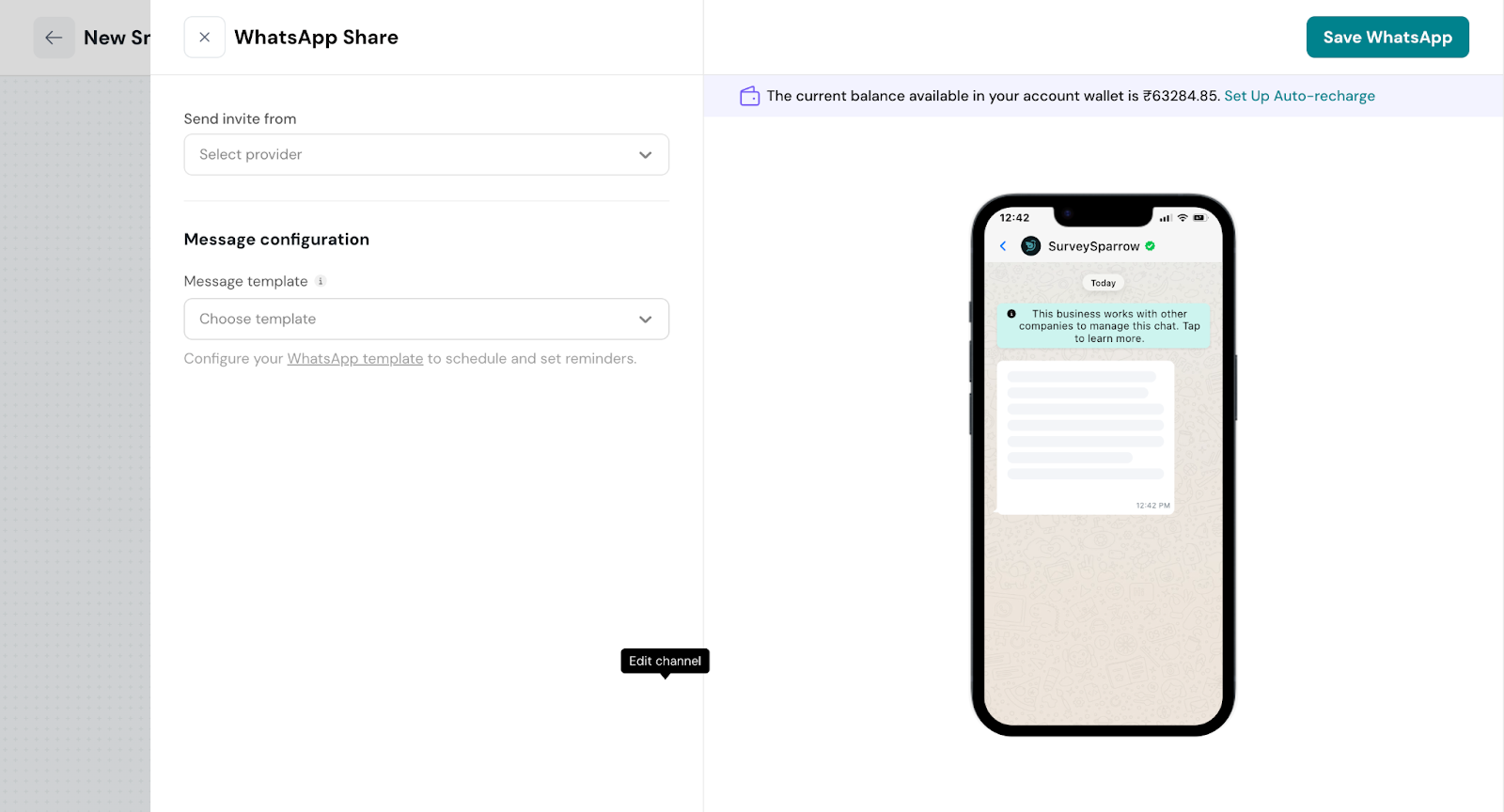
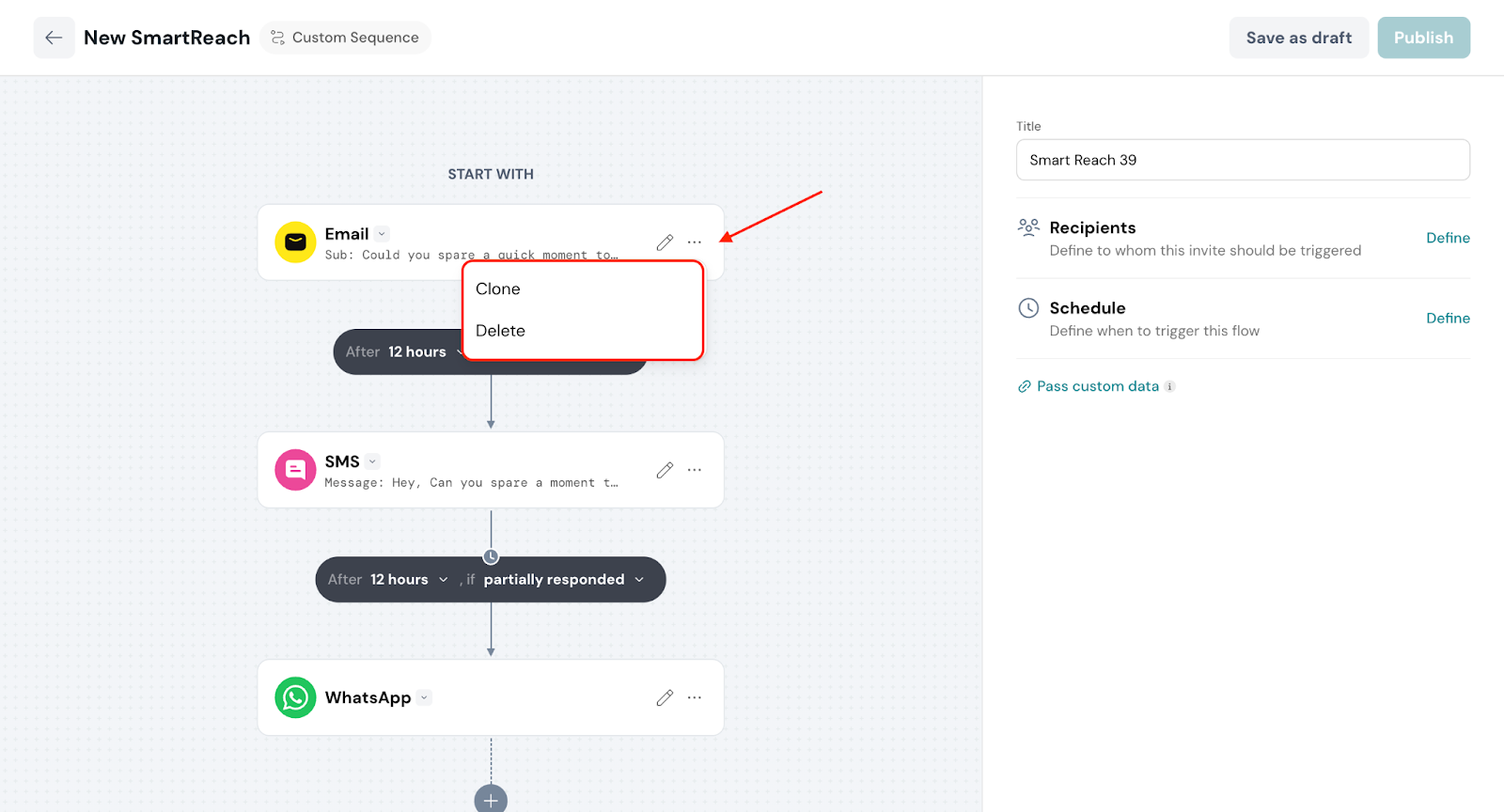
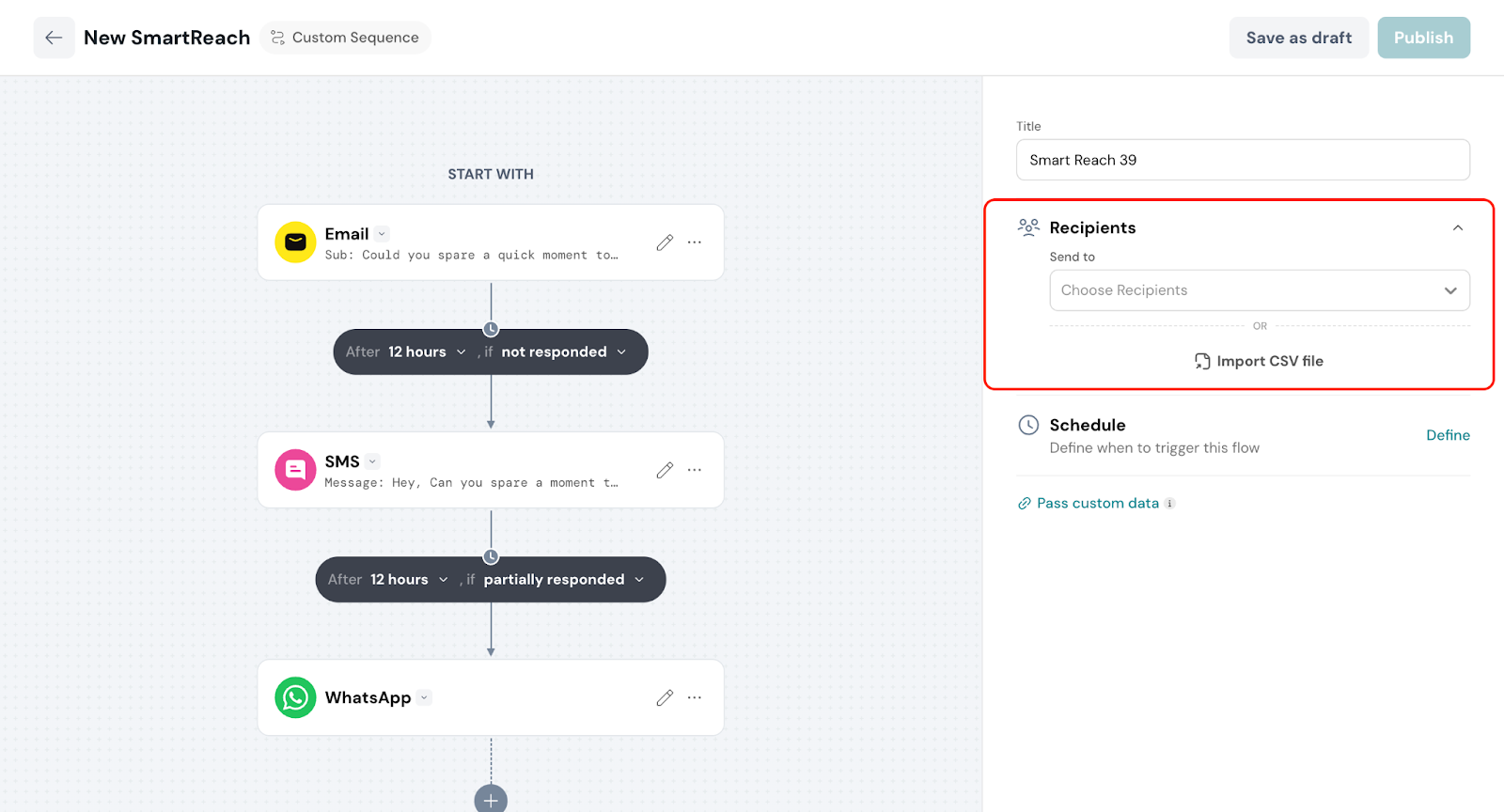
7. You can also schedule when the sequence should start. For detailed scheduling options, refer to Step 6 in the previous section, where we covered options like sending at the best time, on a specific day, or based on conditions.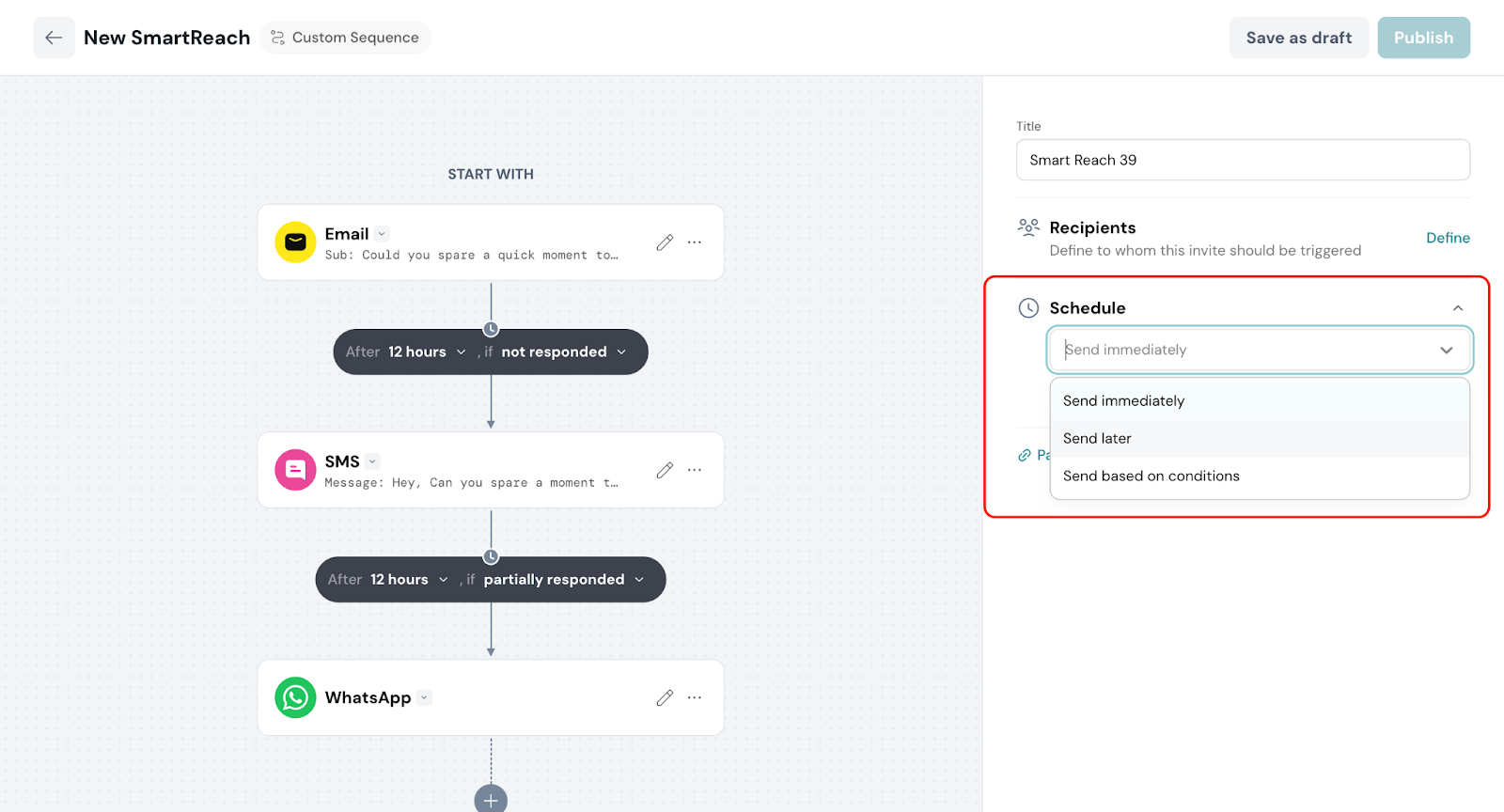
8. Enter a clear, descriptive title for your SmartReach flow to help you identify and manage it easily, especially when running multiple survey campaigns. Choose a name that reflects the purpose or target audience.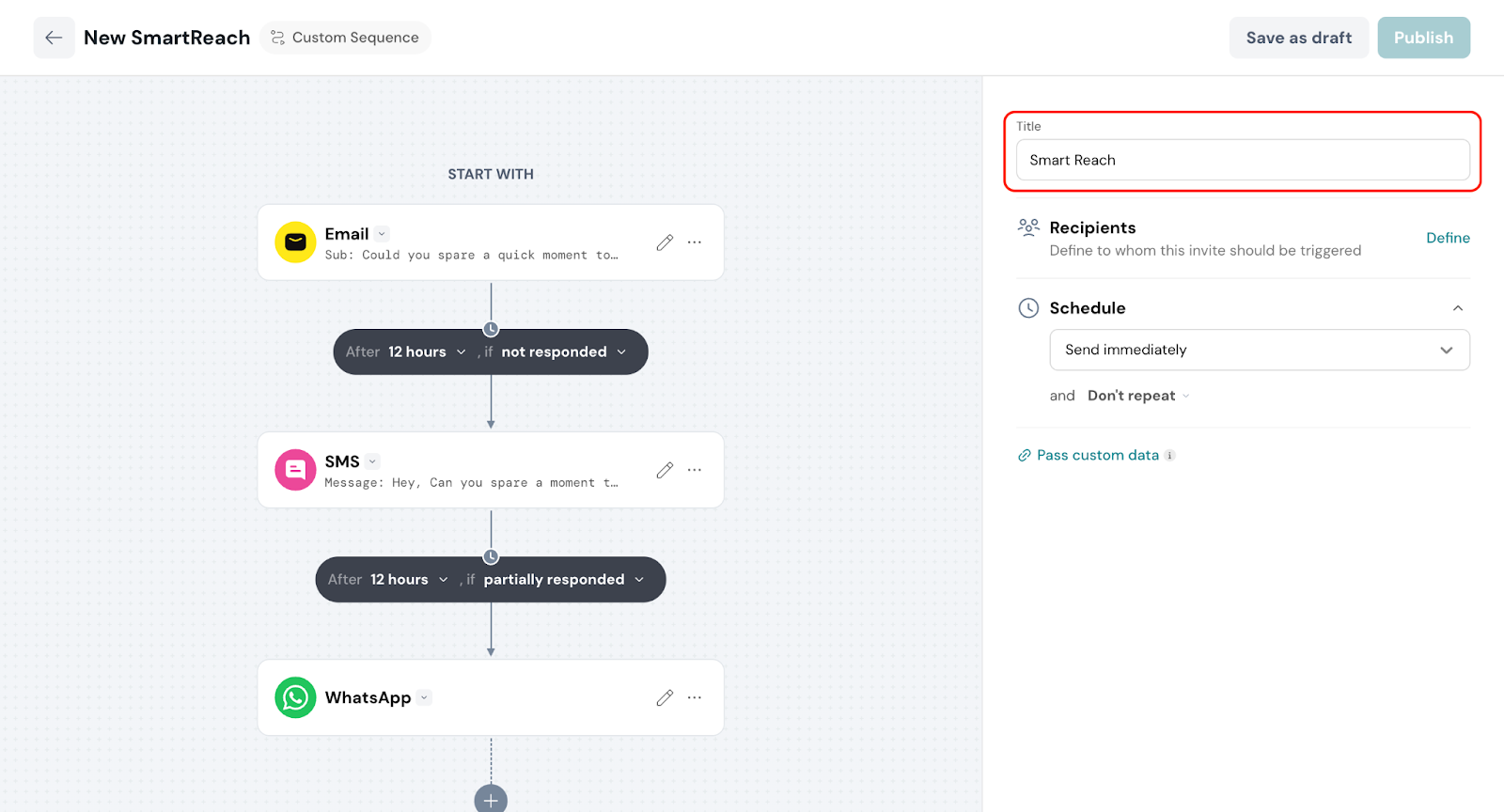
This option sends surveys based on each contact’s stored communication preference, such as prioritizing Email over SMS, or vice versa. It’s especially useful when trust and user experience are key. By respecting how your customers prefer to be reached, you reduce fatigue, avoid annoying your audience, and build long-term engagement. This mode is great for brands that emphasize respectful, user-centric communication.
Example- A leading financial services provider wants to collect feedback after important interactions, such as opening a new account or completing a loan process. Given the sensitivity of customer data and the need to maintain trust, the CX team aims to communicate in a way that feels respectful and non-intrusive.
Using Contact Preferred mode in SmartReach, surveys are sent through the channel each customer prefers like Email for detailed messages, SMS for quick replies, or WhatsApp for regular app users.
By aligning with each contact’s preferred channel, the company avoids overwhelming customers, reduces opt-outs, and builds stronger engagement. This personalized, trust-first approach is especially valuable for any brand that prioritizes customer experience, engagement, and respectful communication.
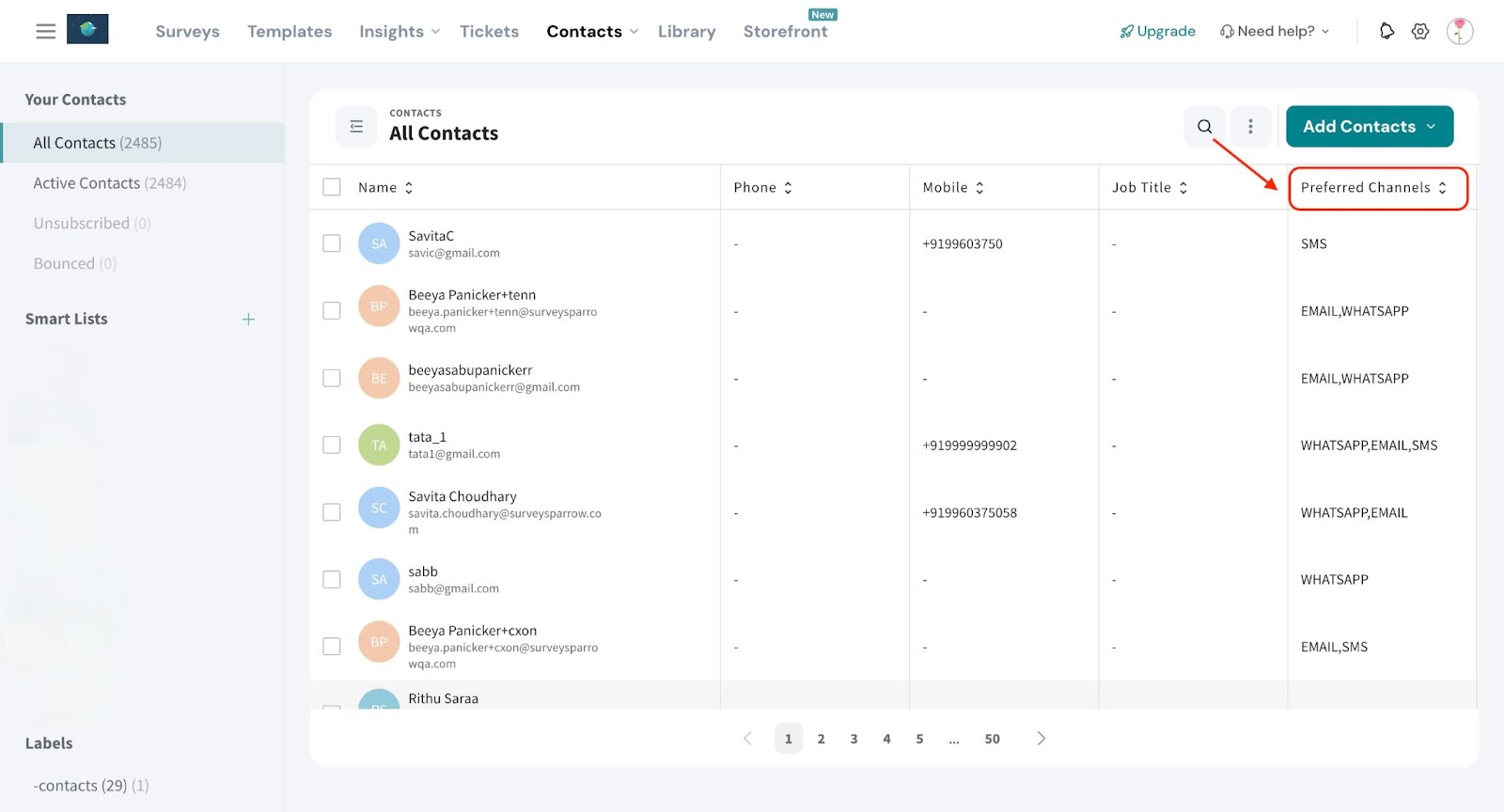
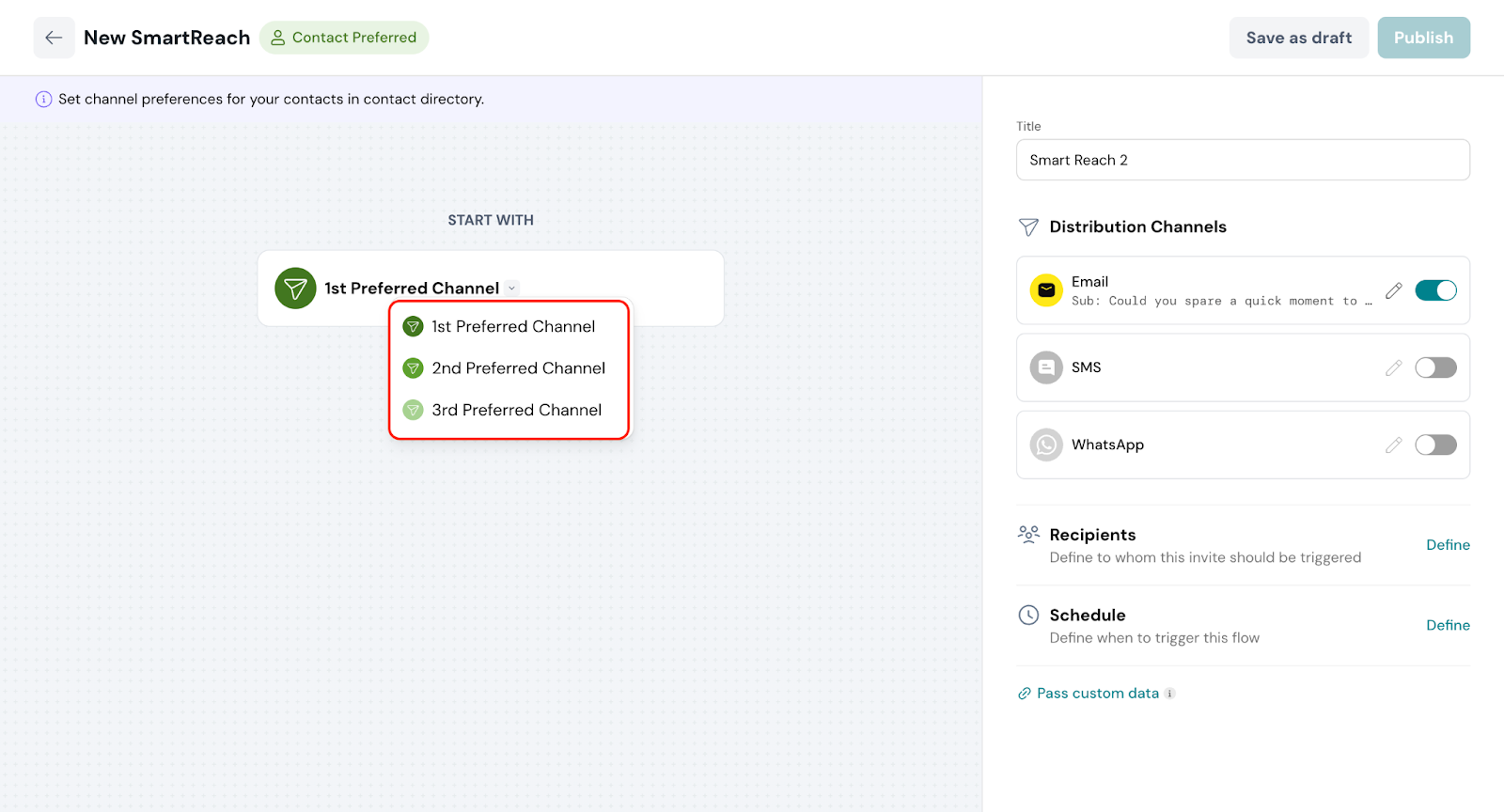
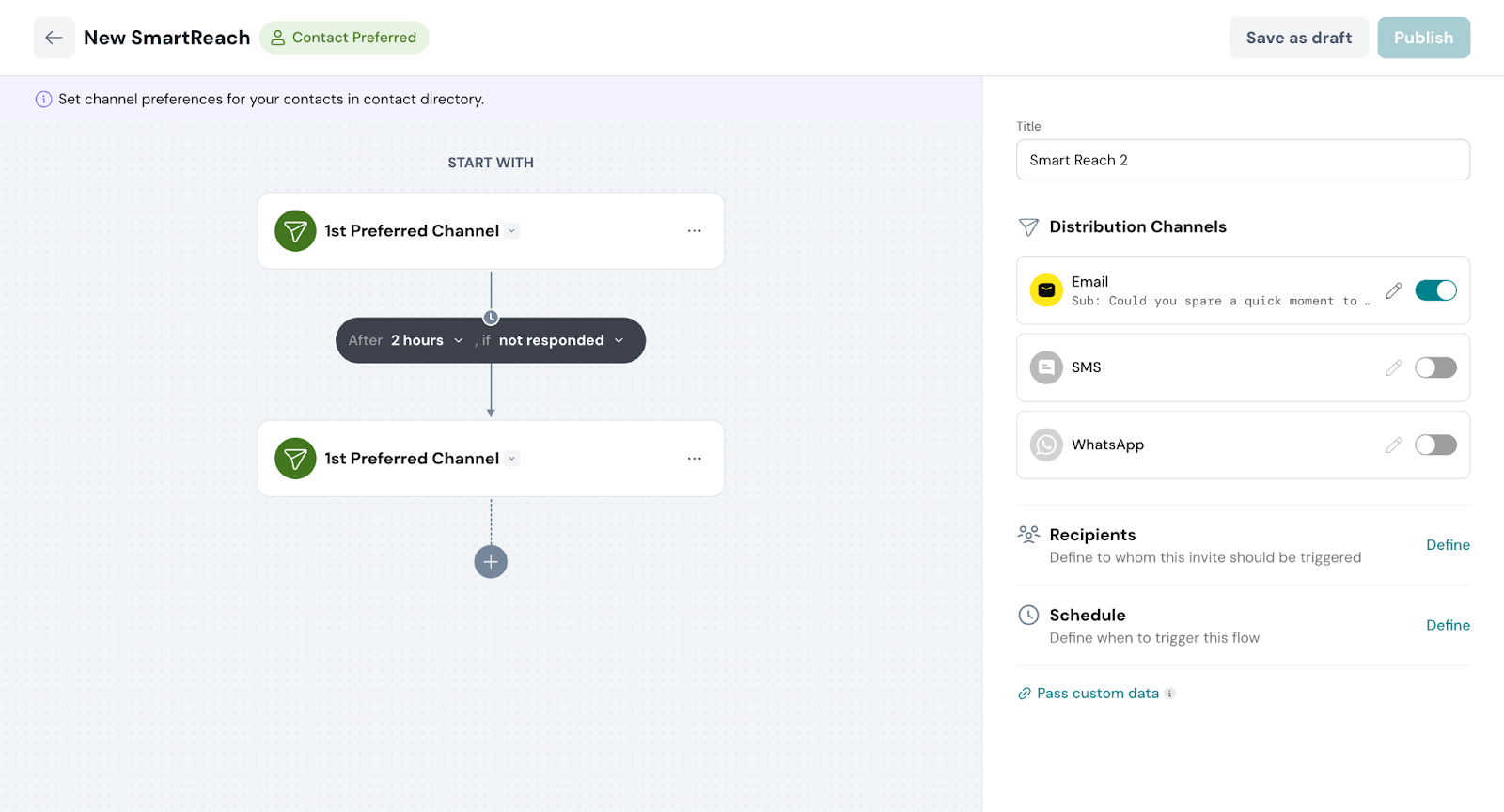
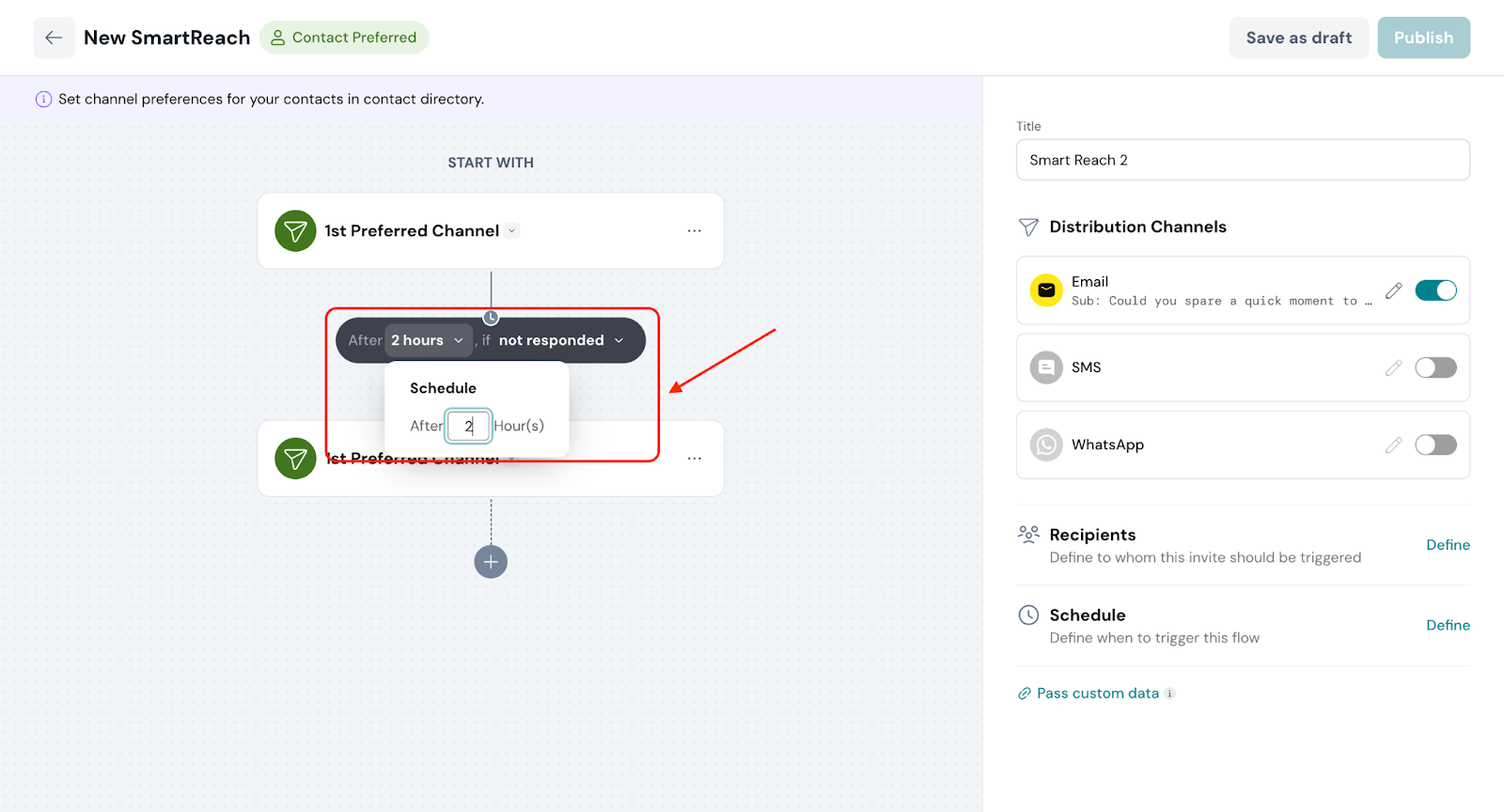
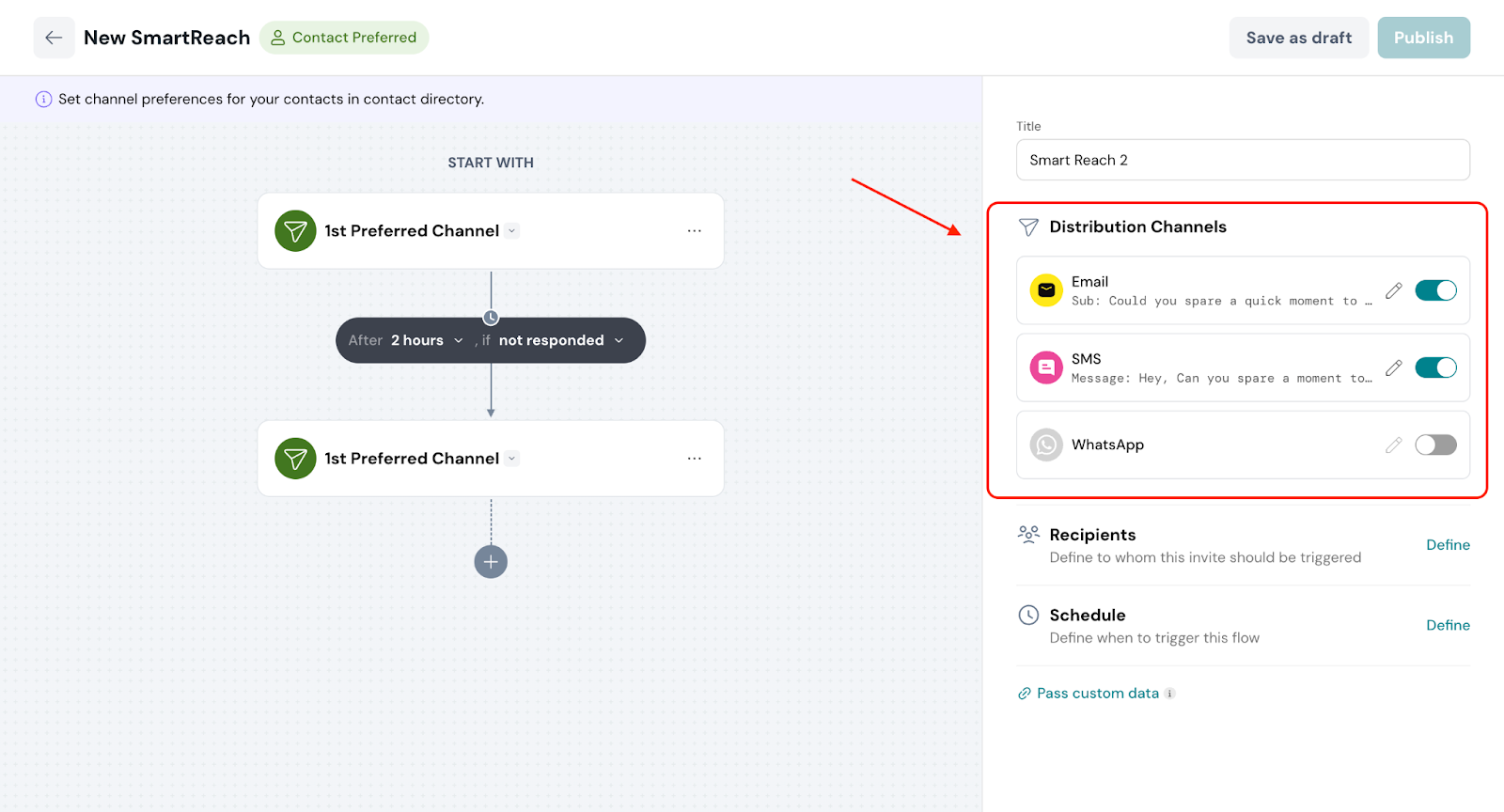
Broadcast sends the survey through all the selected channels simultaneously. It’s the most aggressive delivery method and is best reserved for urgent situations like time-sensitive feedback collection or critical service-related outreach. Since it reaches users on multiple platforms at once, it can drive quick responses. However, it should be used with caution to avoid overwhelming your audience or being flagged as spammy.
Example- An e-commerce company experiences unexpected shipping delays during a high-volume festive season sale. With thousands of orders impacted, the CX team needs to quickly understand how customers are feeling and identify any recurring issues—before negative sentiment escalates.
To ensure immediate and widespread outreach, they activate Broadcast mode in SmartReach. This sends a short feedback survey instantly across all selected channels - Email, SMS, and WhatsApp so customers receive it on the platform they’re most likely to see first.
Because of the time-sensitive nature of the situation, Broadcast ensures the widest and fastest coverage. Customers can respond on the channel of their choice, and the CX team gets real-time insights into common concerns like delay frustration, packaging issues, or missing updates. This enables them to prioritize follow-ups, inform internal teams, and send reassurance messages.
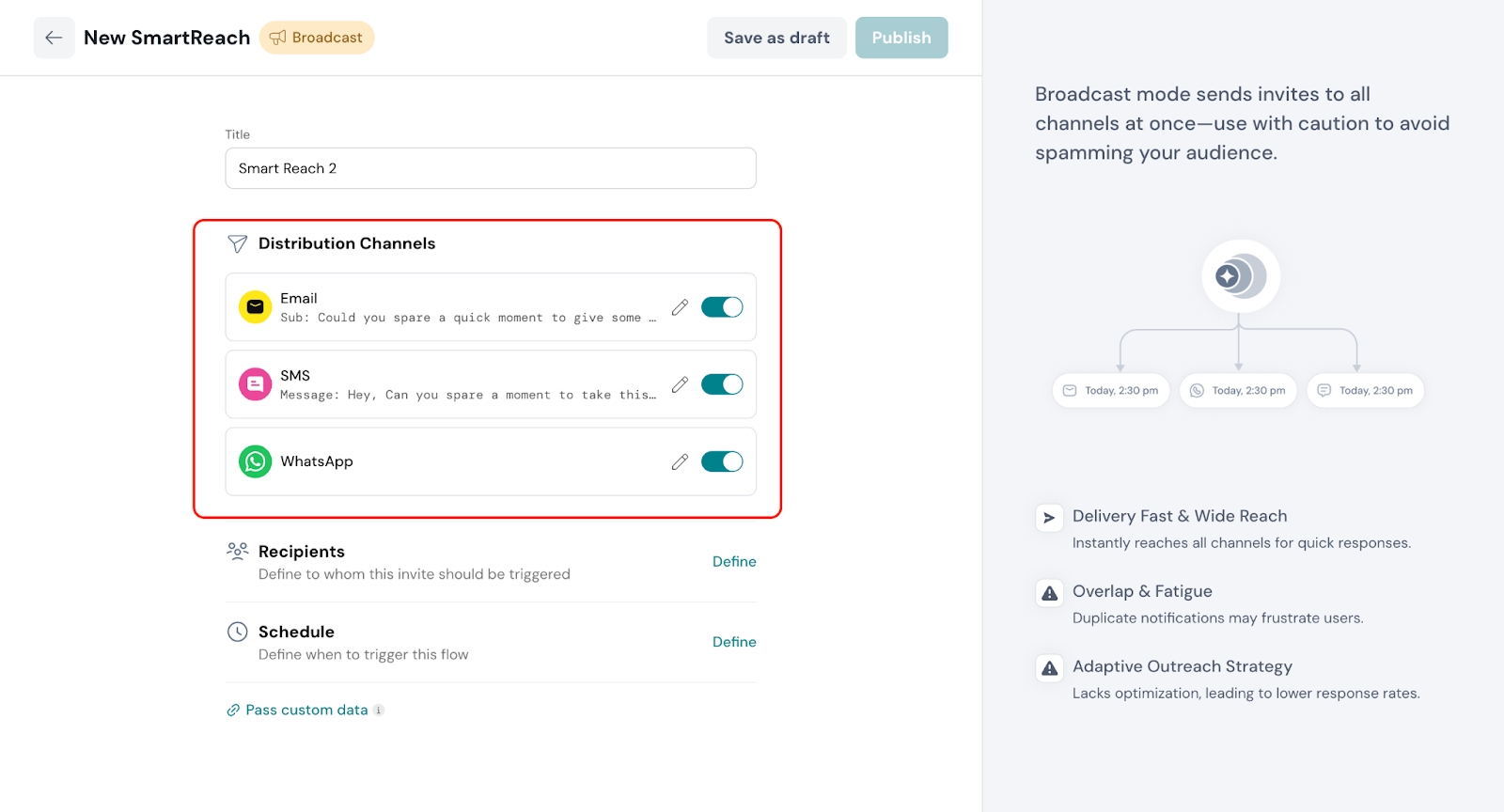
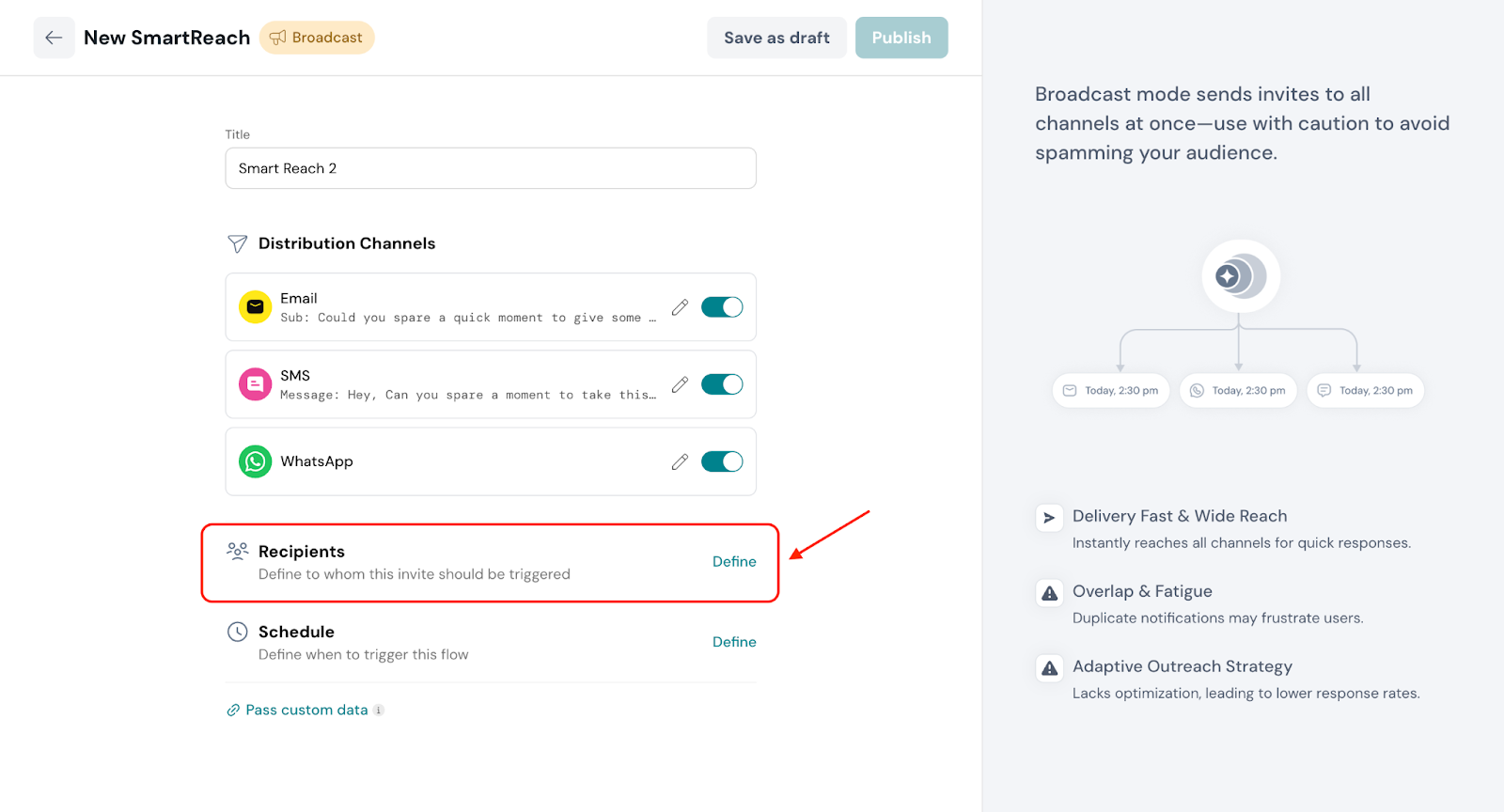
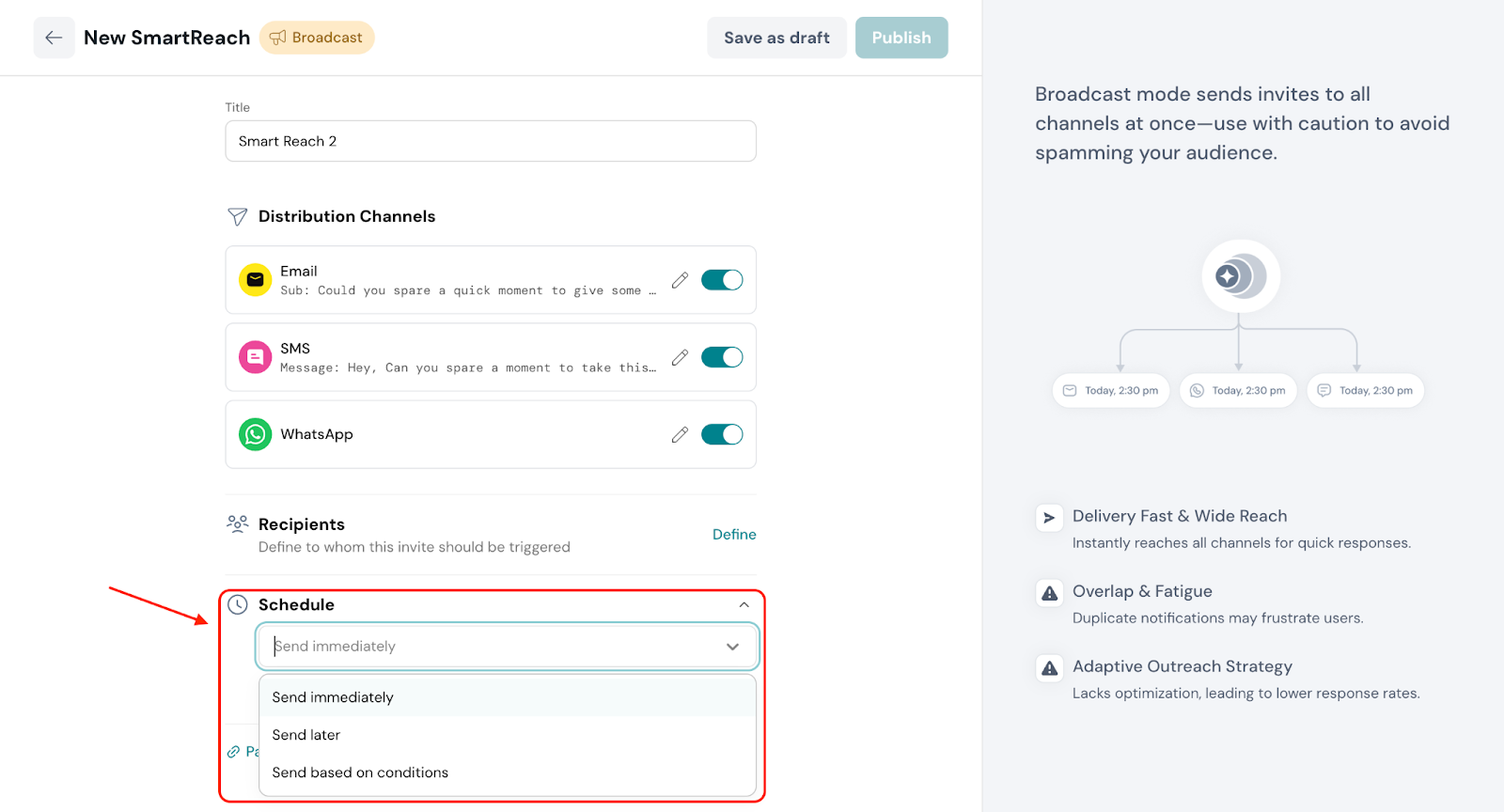
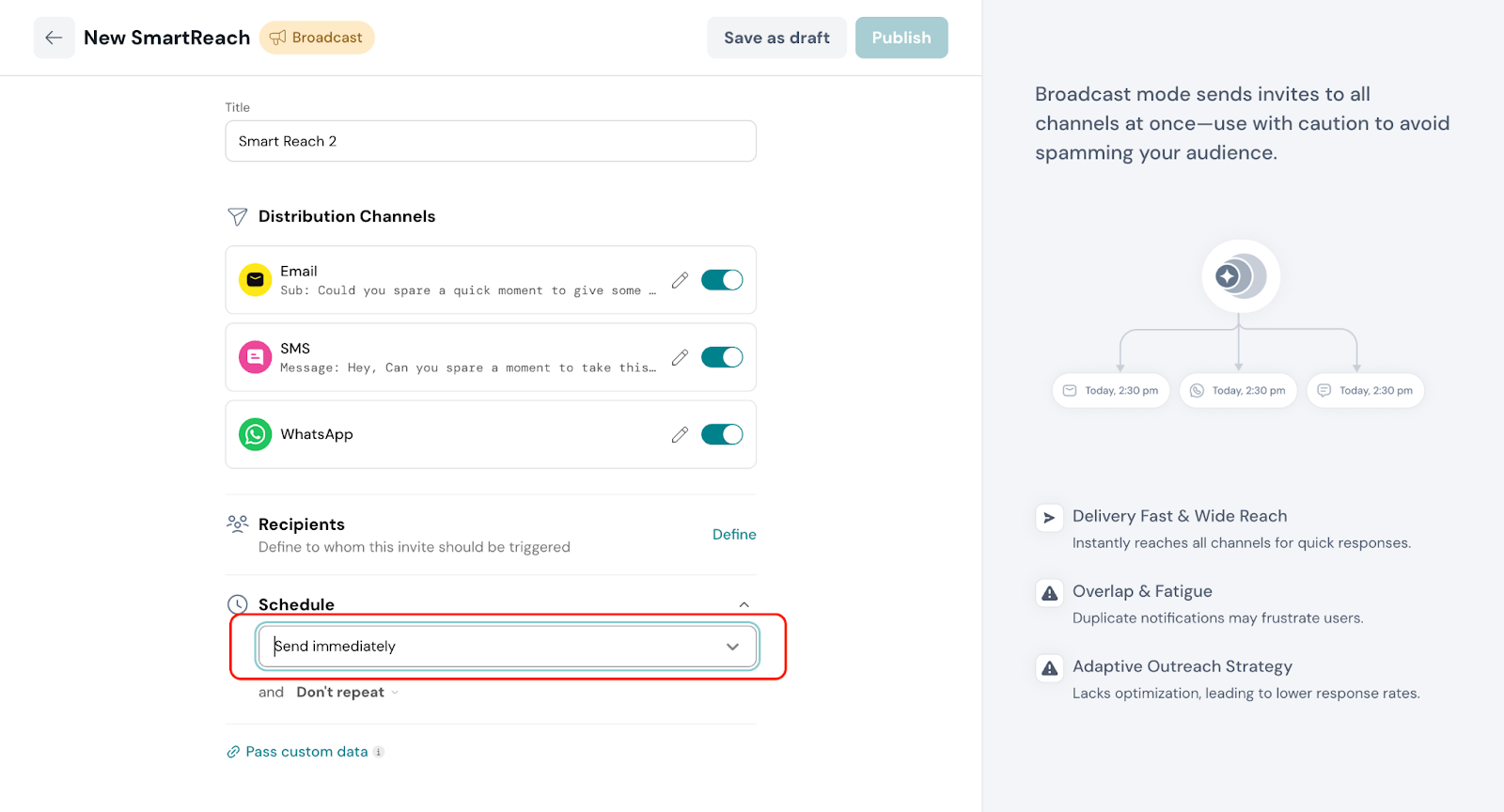
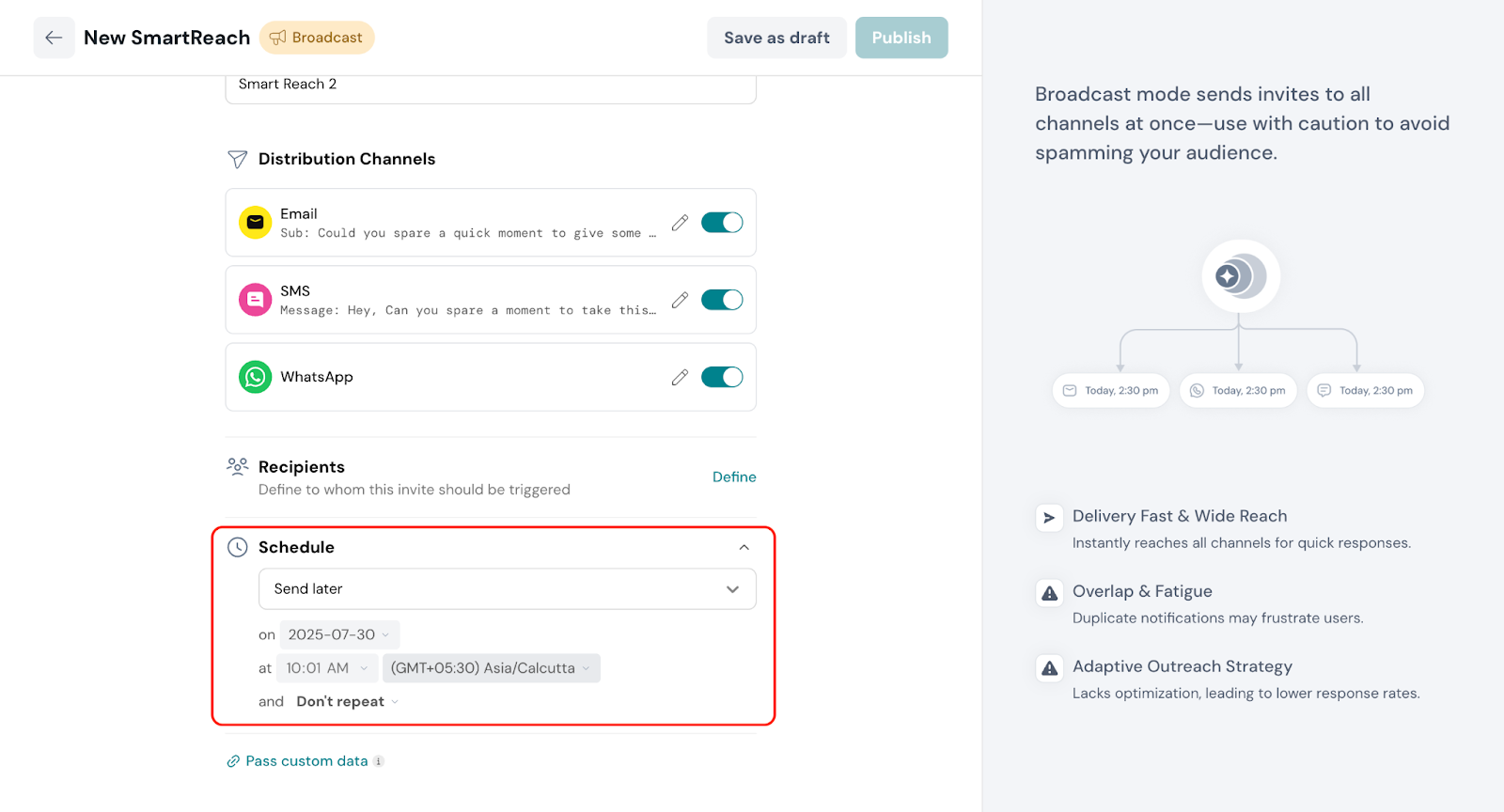
Eg- As part of the flash sale feedback campaign, the e-commerce brand uses Send Based on Conditions to trigger surveys only if the order was delivered 2 days ago. This means the survey will be sent only when this condition is met, ensuring that feedback is requested
at the most relevant time for each customer.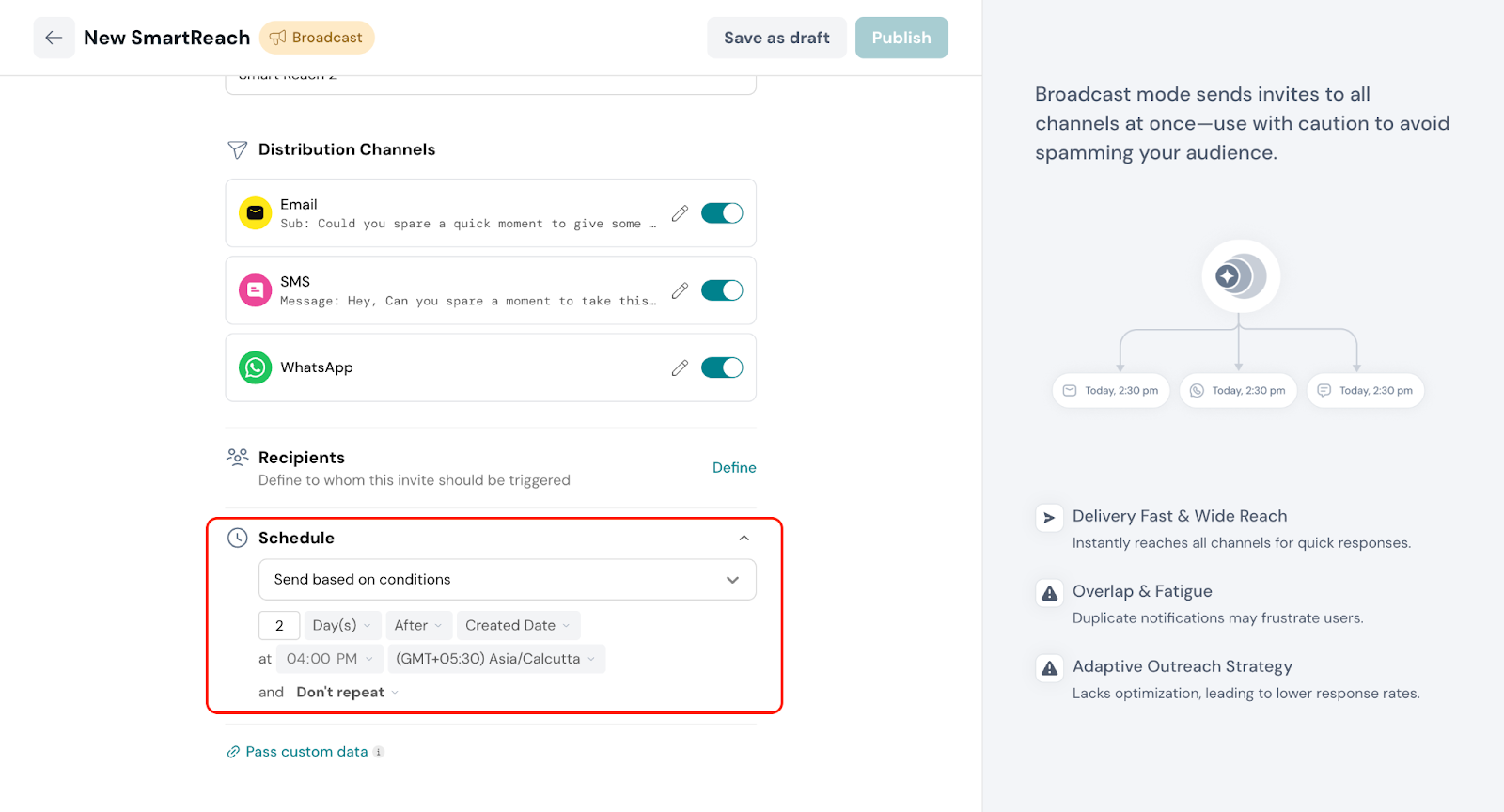
Once your campaign is active, you will be able to track performance with analytics. This helps in understanding which channel performed best, which time slots had the highest engagement, and how your audience is responding overall.
To view the analytics, click on the Analytics icon in the SmartReach distribution dashboard.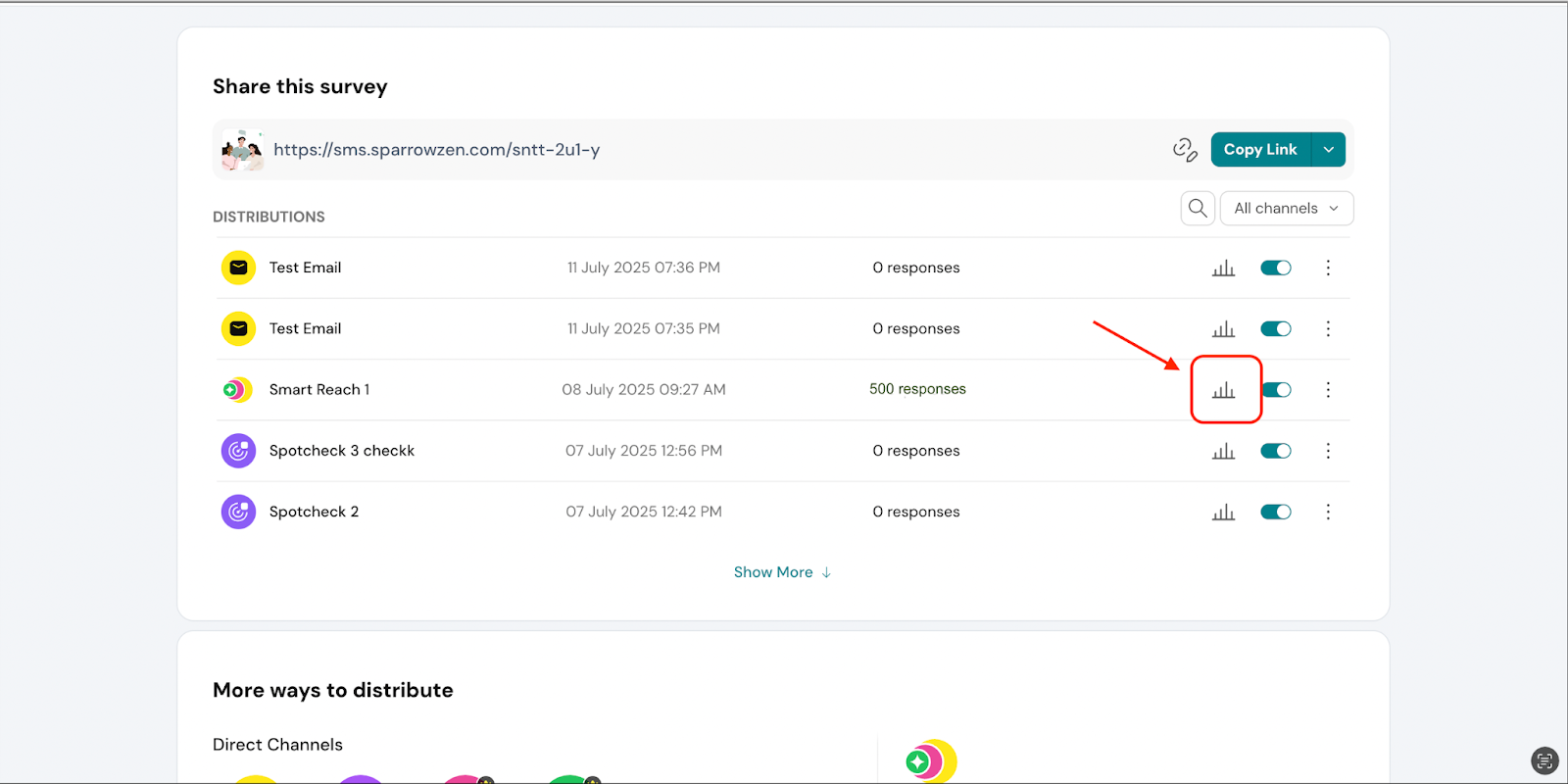
For Email, you’ll be able to view key metrics such as the number of emails sent, opened, survey links clicked, and the number of responses received.
A graphical trend chart provides a visual overview of performance over time.
Additionally, you can access invite logs below the chart, which display detailed, date-wise information including emails sent, opens, responses, and response rate (%).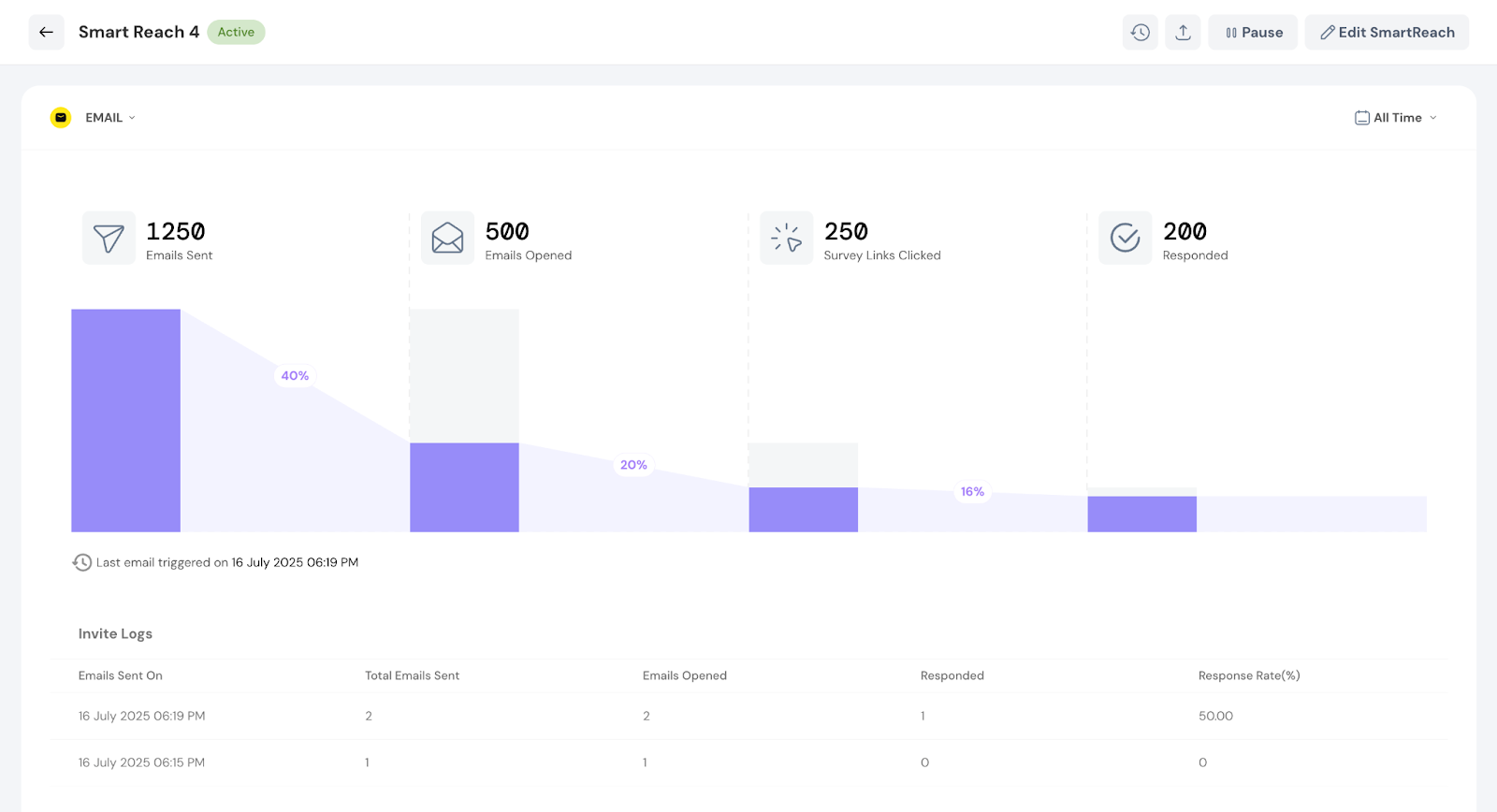
For SMS, you can track key metrics including the total number of SMS sent, the number of SMS delivered, and the responses received.
A graphical chart shows the response rate trend over time, followed by invite logs that provide a detailed, date-wise breakdown of SMS sent, delivered, responses received, and the response rate (%).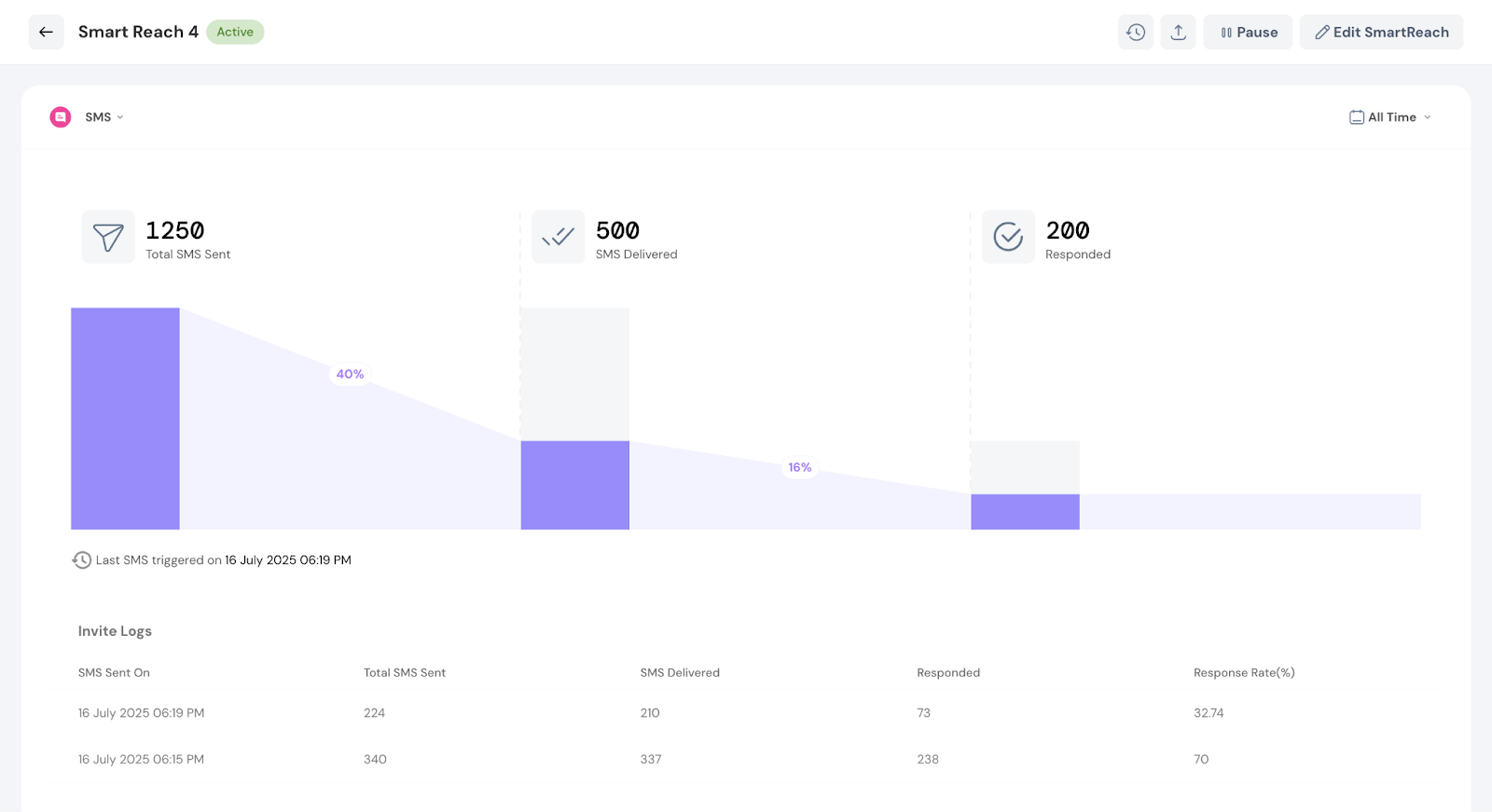
For WhatsApp, you can track the total number of messages sent, messages delivered, and the number of responses received.
A graphical chart displays the response rate trend, followed by invite logs with a date-wise breakdown of messages sent, delivered, responses received, and the response rate (%).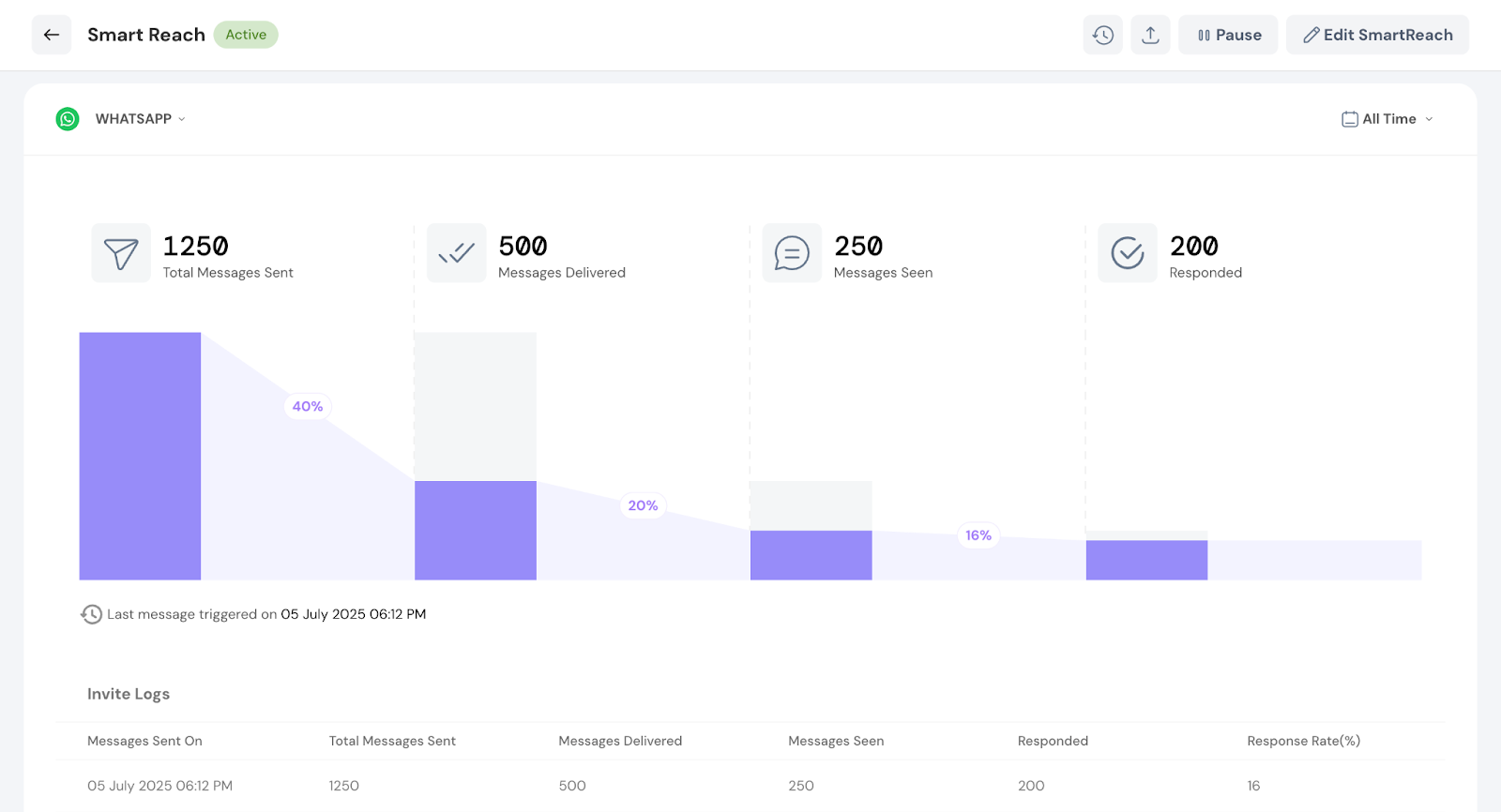
If you've selected multiple channels for your SmartReach campaign, you'll be able to choose the specific channel: Email, SMS, or WhatsApp for which you want to view analytics.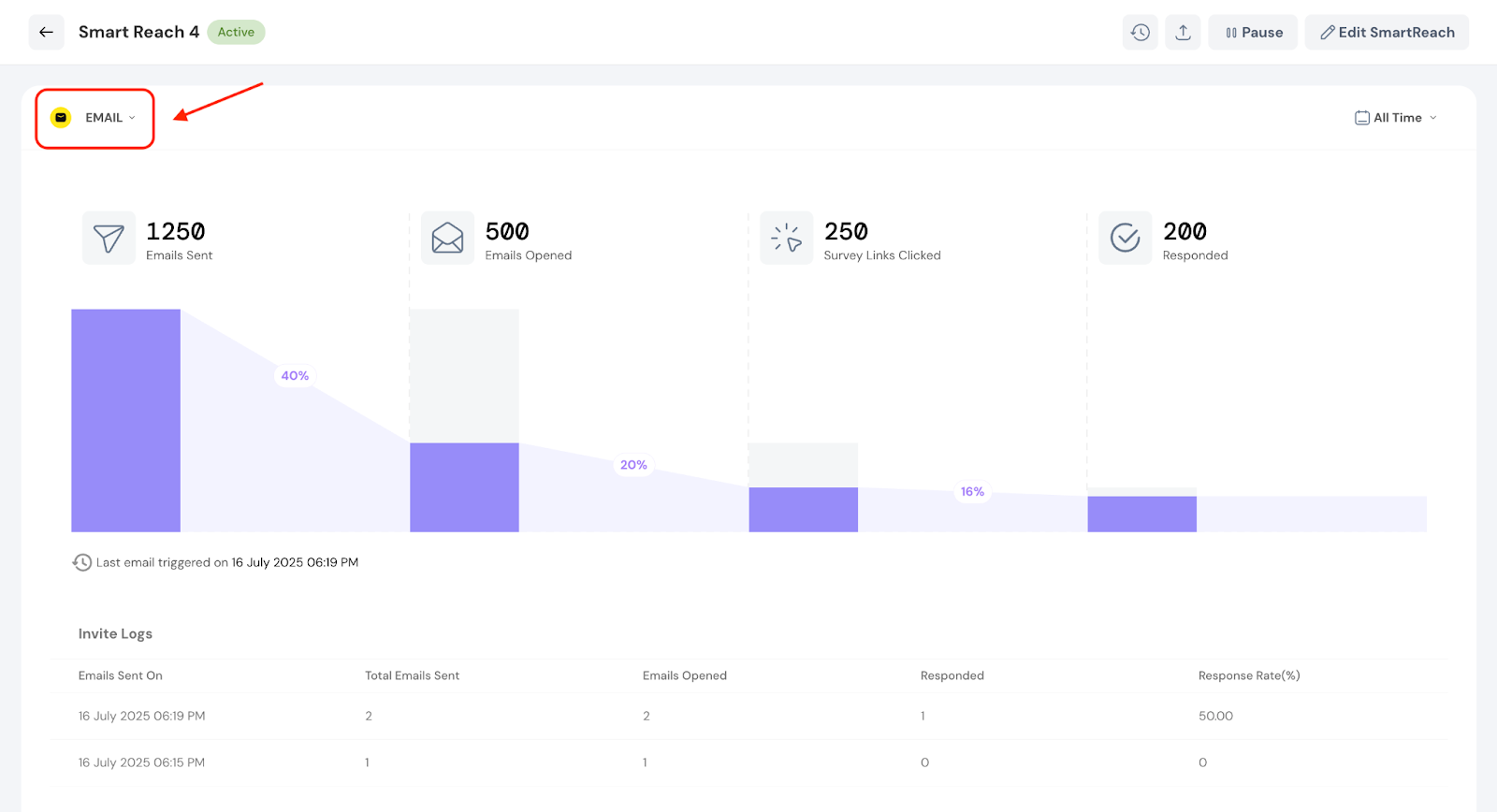
You can also filter the analytics by time, such as last 7 days, last 30 days, or select a custom date range to view SmartReach performance for a specific period.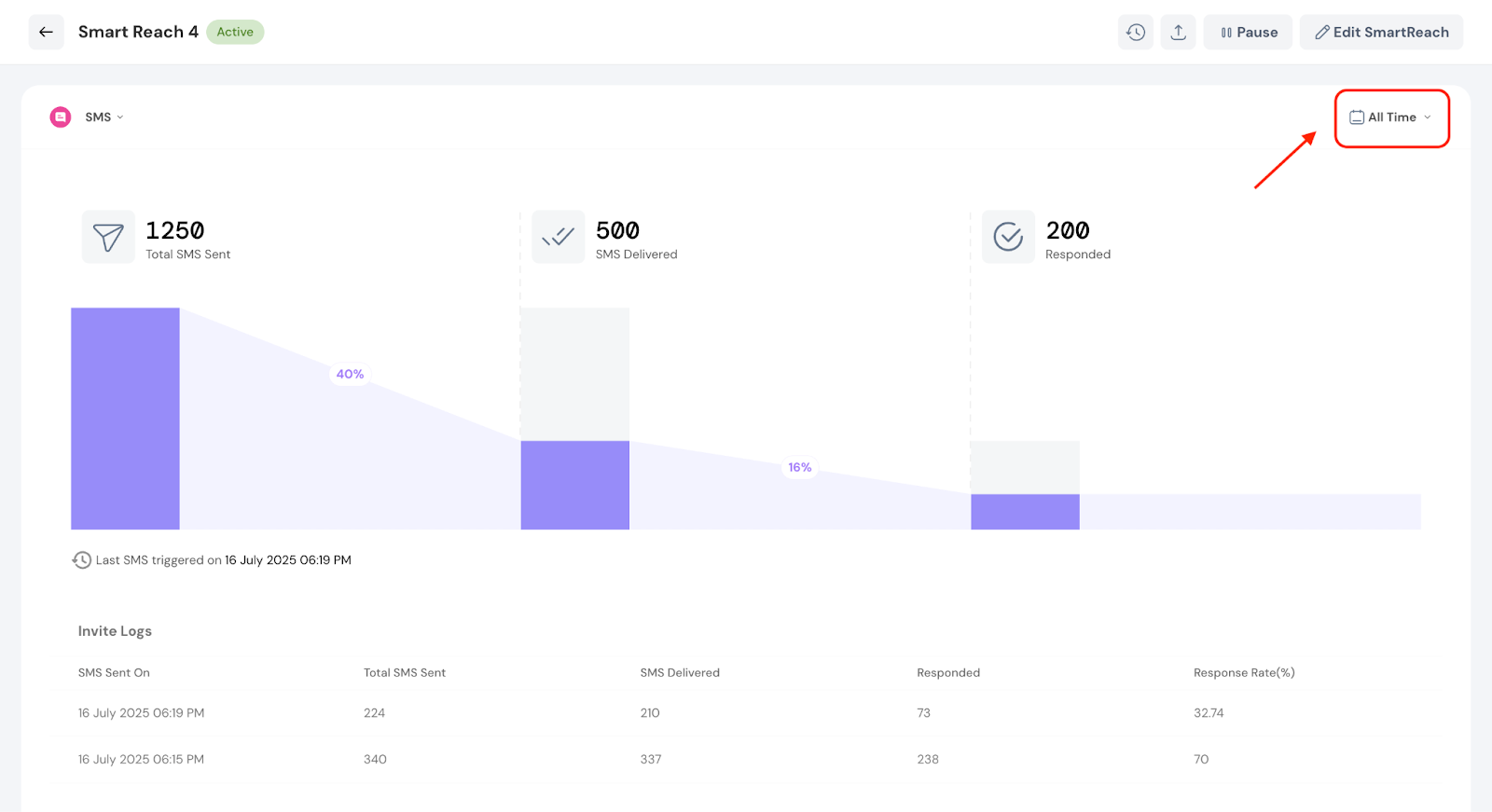
You will be able to see the channel history, which helps you track the sequence of channels used, understand which channel triggered engagement, and analyze the overall effectiveness of your outreach strategy.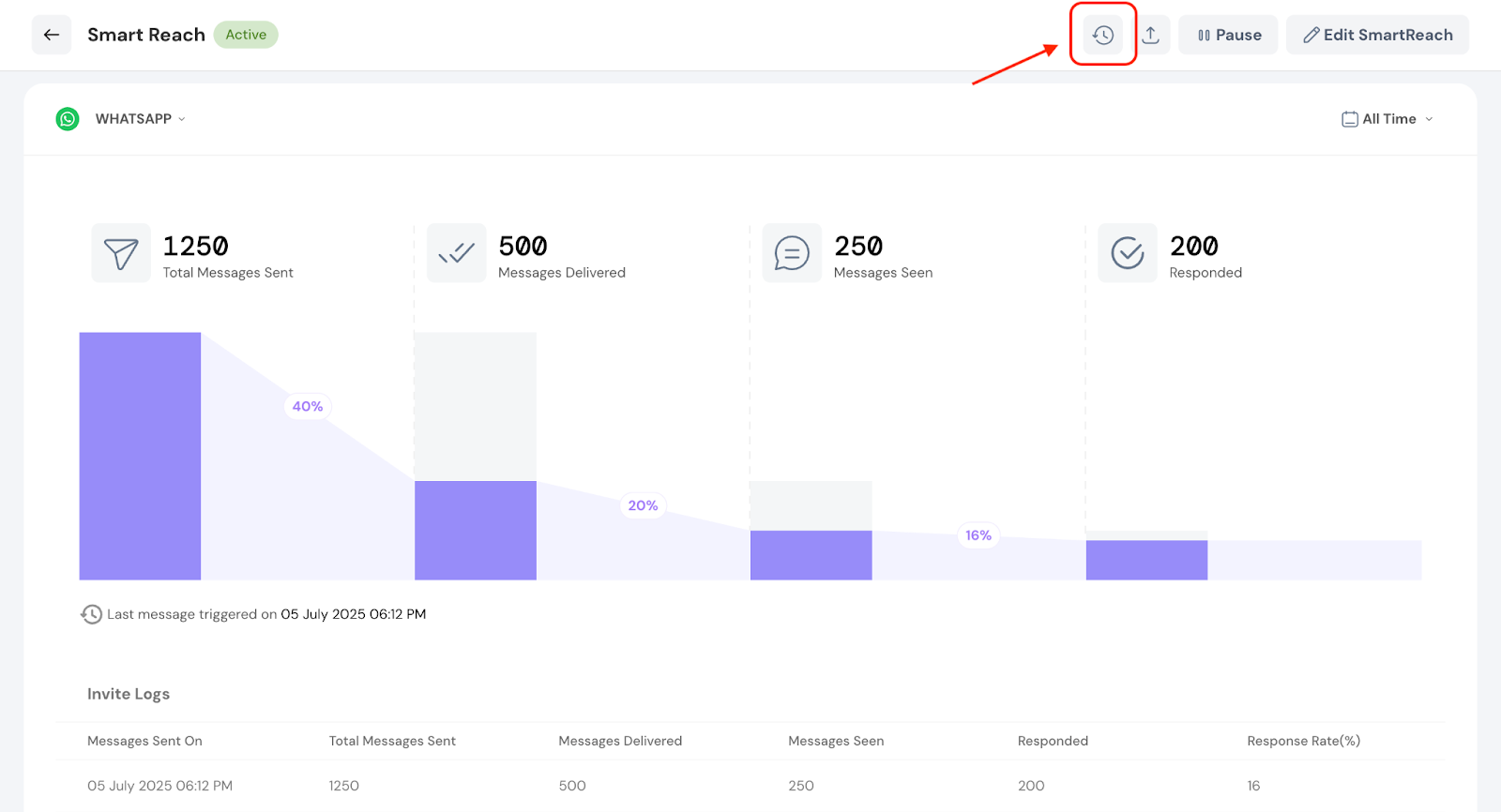
You can also export the analytics data as a CSV file for further analysis or reporting.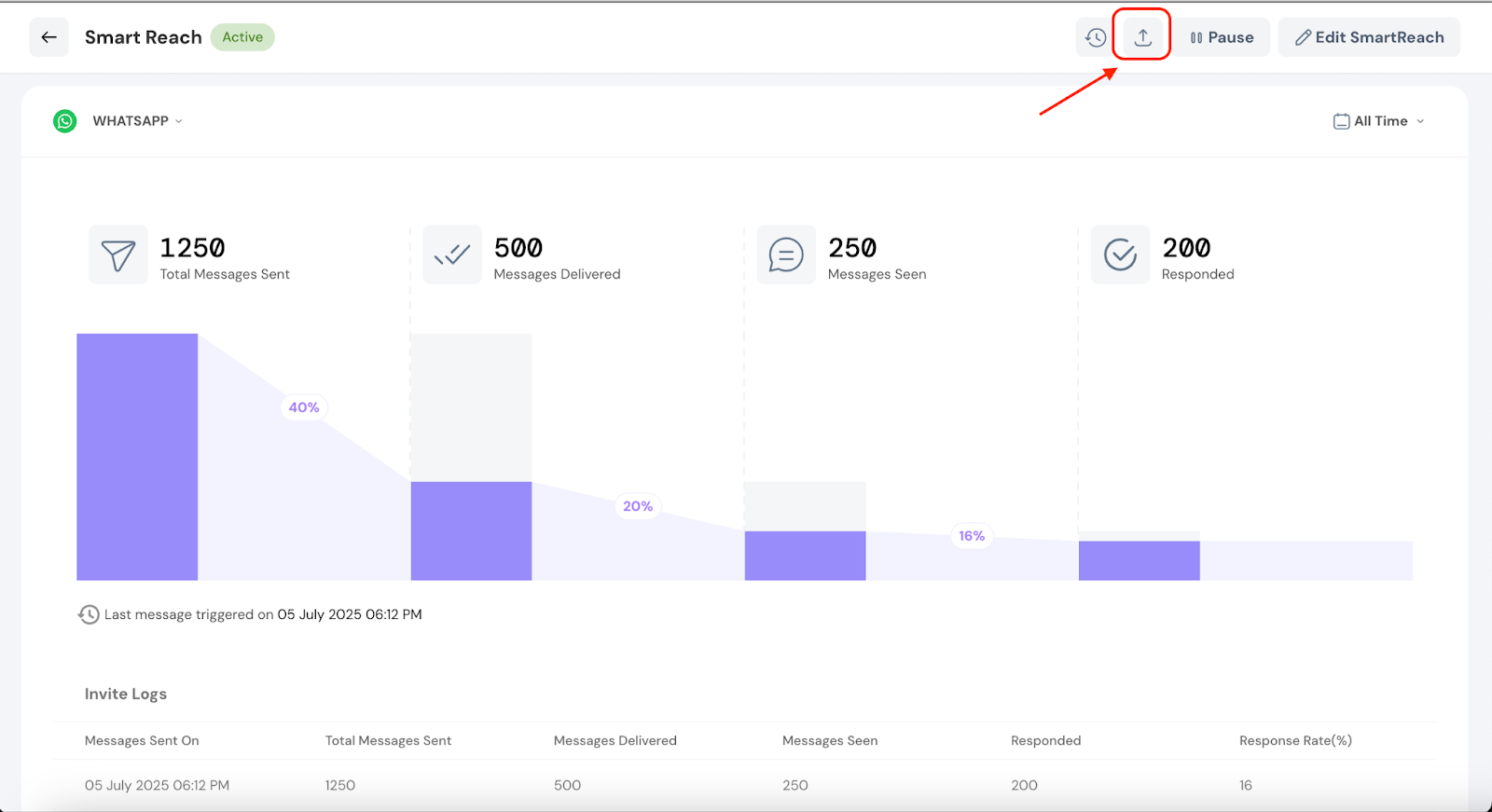
You will be able to pause the SmartReach campaign at any time if you wish to temporarily stop survey distribution.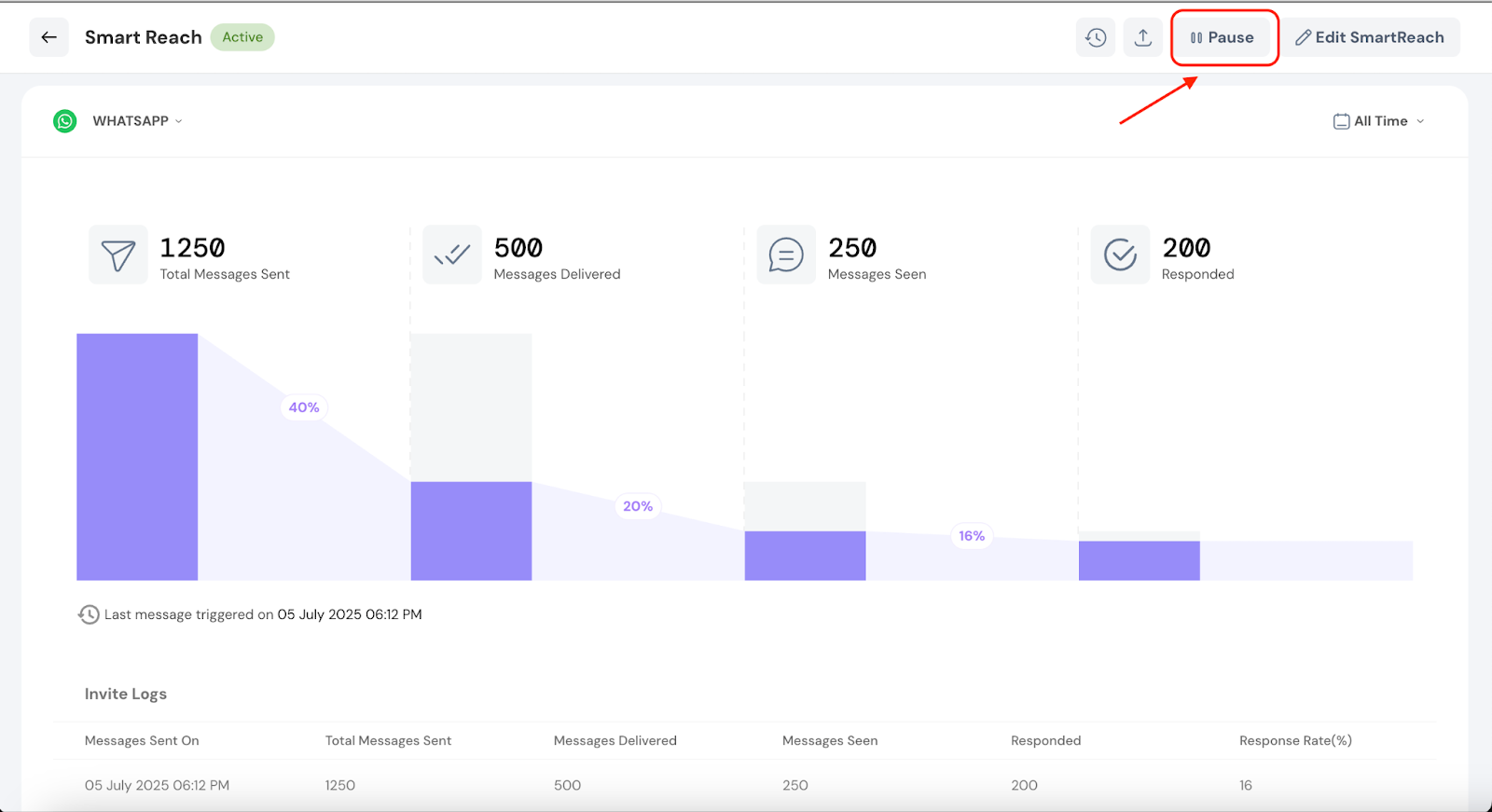
You can also edit the SmartReach campaign to make changes to the selected channels, update sequences, or adjust other configurations as needed.
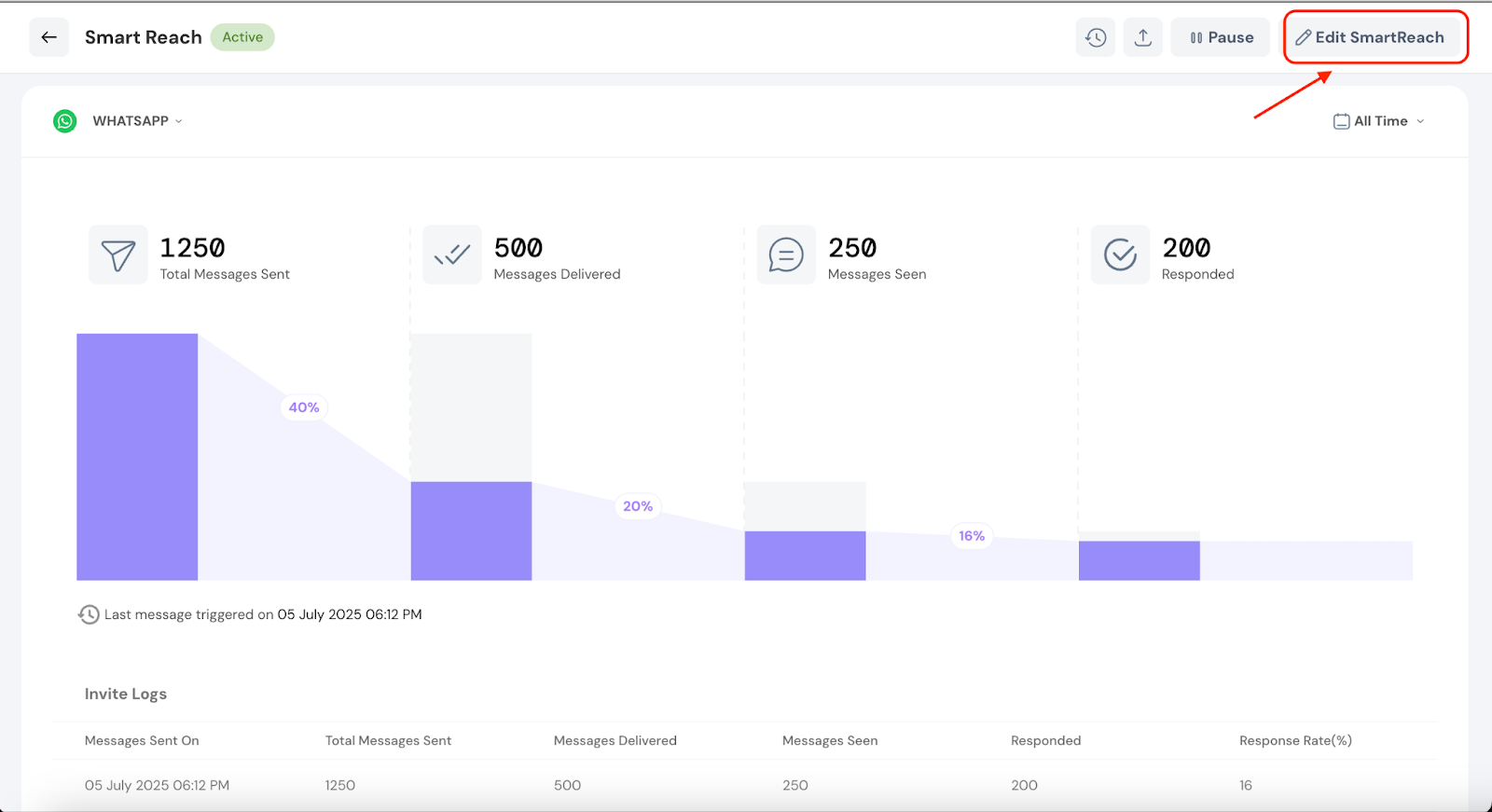
That's all about Smart Reach.
Feel free to reach out to our community if you have any questions.
Powered By SparrowDesk